IN-CALF RATE SNAG
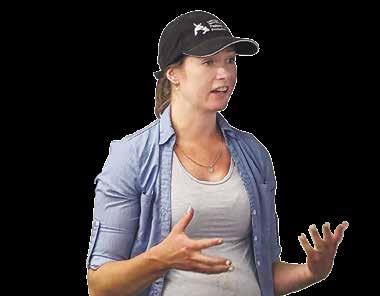
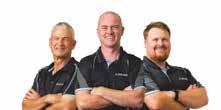
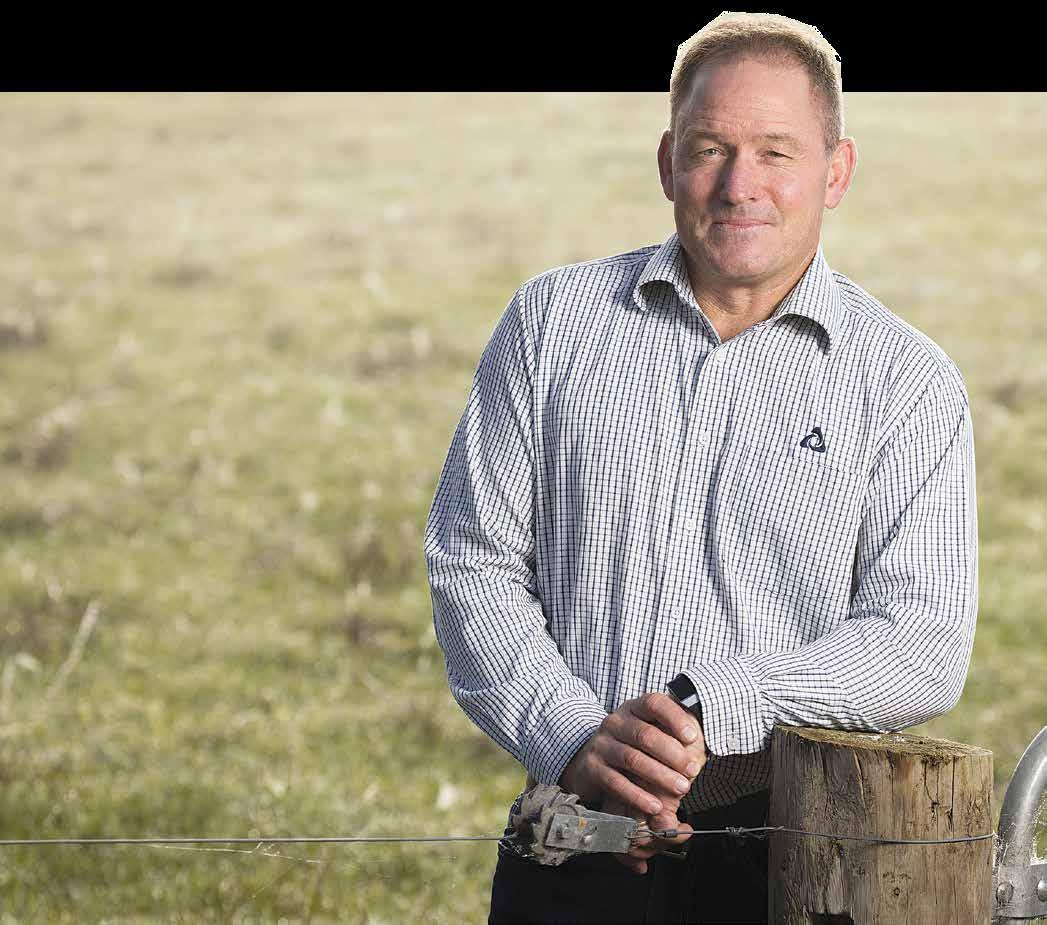

Page
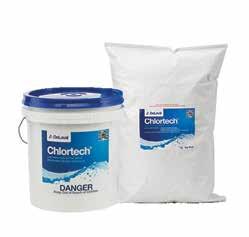
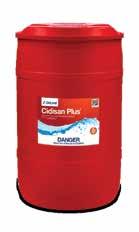
will
million kgMS
“I calculate that this
result in 2.7
not being produced and effectively lost.”
Green grass ‘hiding reality’. PAGE 6 Making healthier FEEDING OUT More bales for cows
– Malcolm Ellis, LIC
PAGE 3
20 APRIL 18, 2023 ISSUE 516 // www.dairynews.co.nz delaval.com Talk to the Upgrade Specialists 0800 222 228 Try our value-range of detergents today. UPGRADE YOUR CLEANING RESULTS? IS I T T I M E TO ® ® Cidisan Plus & Chlortech
Animal genetics helps farmers improve milk production, environmental footprint, and health traits through better breeding decisions. The benefits of genetic gain compound so that each generation of animals is better than the last, and this has a significant and positive impact on farm profitability.
Dairy is an international game, and our rate of genetic gain must be internationally competitive.
As a subsidiary of DairyNZ, NZAEL leads the cooperation of farmers, AI companies and bull breeders to optimise the national dairy herd through ongoing improvement in genetic evaluation.
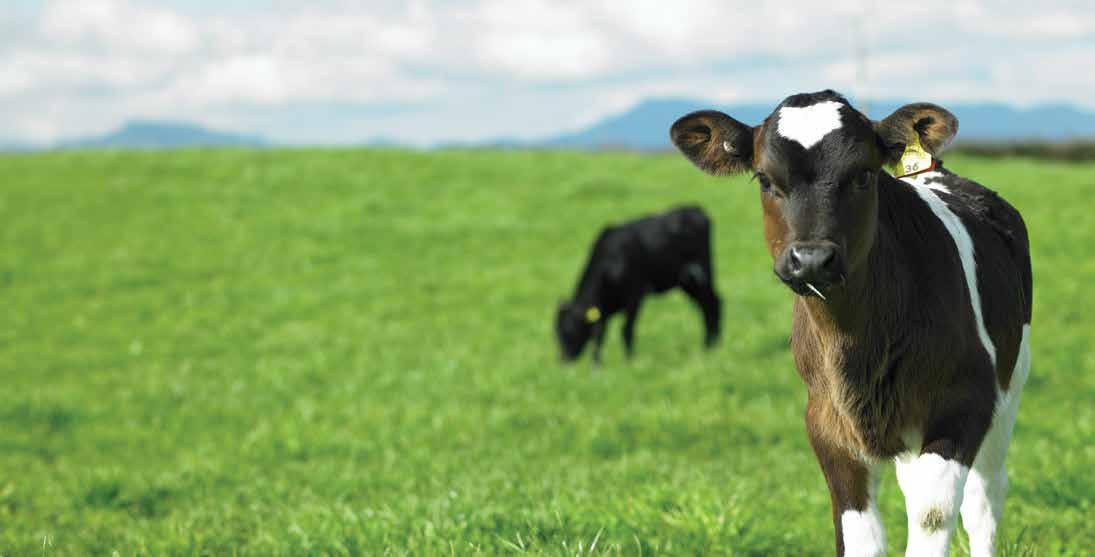
SETTING THE STANDARD
NZAEL’s first role for farmers is to improve genetic gain by setting and continuously improving the National Breeding Objective (NBO) and the Breeding Worth Index (BW). Breeding Worth sets the standard of what a good cow looks like for our farmers. We keep BW relevant and world-leading by bringing in new traits and improving the data quality, and we annually update the economic value of each trait. (E.g. fat, protein and fertility)
Breeding Worth (BW) is the independent, industry good index available to all.
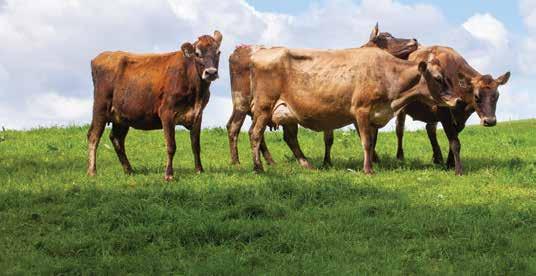
INDEPENDENT AND TRANSPARENT
NZAEL’s second role for farmers is to evaluate all animals in the national herd using the BW index. These results are made available to everyone in the sector through AI companies, bull catalogues, herd record providers and the complete and independent comparison of AI bulls published in the Ranking of Active Sires (RAS) list on the DairyNZ website.
This information provides confidence to farmers in the decisions they make to improve their herd through breeding, buying, and culling.
WORLD LEADING SCIENCE
NZAEL is at the forefront of farm systems and genetic science and works with local and international experts to create the most profitable herds possible. We do this by researching on-farm performance related to genetics and identifying how genetics can support improvements in the farm system. We collaborate with the world’s leading scientists to deliver the best BW for farmers and invest in continuous improvement of evaluation methods and traits that matter most.
NZAEL is the independent industry good organisation for genetics and animal evaluation. It has its own Board of Directors with accountability to the DairyNZ Board and follows a rigorous testing process that includes farmers and experts for all improvements or changes to BW. Every improvement is tested with these groups before sign-off from the NZAEL board and we communicate everything we do with farmers and sector.
Find out more about how NZAEL is delivering for dairy farmers at www.dairynz.co.nz/NZAEL
NEW ZEALAND ANIMAL EVALUATION LIMITED (NZAEL) IS YOUR LEVY FUNDED ORGANISATION WORKING TO INCREASE GENETIC GAIN IN THE NATIONAL DAIRY HERD TO HELP KIWI FARMERS BREED BETTER COWS AND MAKE BIGGER PROFITS.
Helping Kiwi dairy farmers breed the worlds best cows, in NZ.
Empties could cost $20m next season
ONE OF the highest numbers of empty cows in recent years could cost the dairy industry more than $20 million dollars next season.
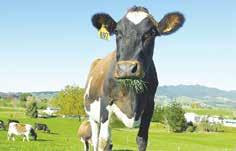
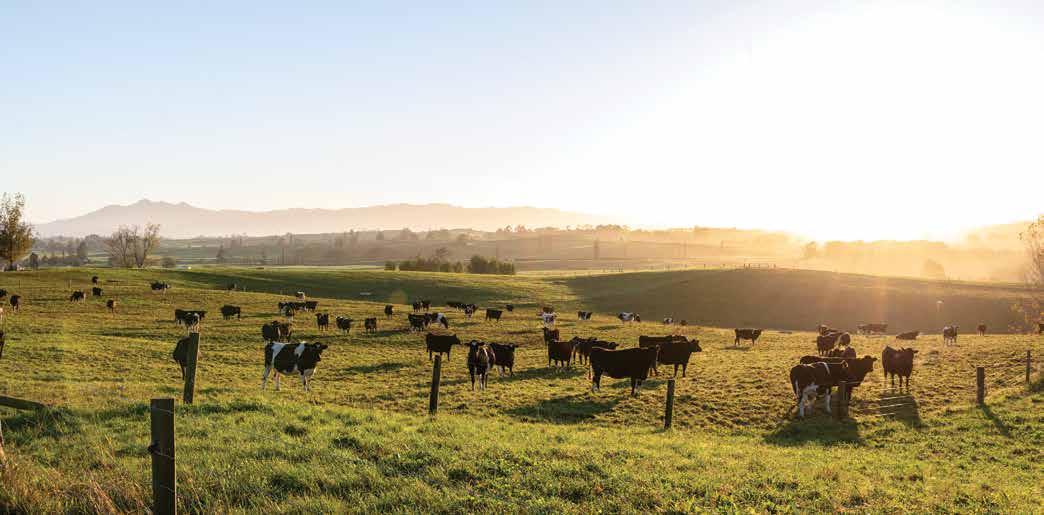
It will also have huge implications for the meat industry with more cull cows destined for processing and this in turn could have implications for export returns for beef and dairy.
The latest interim statistics just released by LIC are based on data from 4000 farms representing about two and a half million cows.
According to LIC’s general manager New Zealand markets Malcolm Ellis the writing was on the wall last year when their data revealed that the national submission rate was down by 1.3%.
“To put some context around this, I have been in this role with LIC for seven years and up until now the national variance rate has been about point three of a percent (0.3%), so this year’s 1.3% is really significant,” he says.
Ellis says in past years the highs and lows of regions have evened out the numbers and he says, even this year, the higher submission rates in the South Island stopped the numbers being even worse. He says the consequences of the low submission rate means that one percent fewer cows in the national herd will not calve in the first six weeks of the spring.
“I calculate that this will result in
2.7 million kgMS not being produced and effectively lost,” he says.
The consequence of the cows not getting pregnant, says Malcolm Ellis, is the empty rate for this coming season is likely to be around 17.2%. He says last year the final empty rate was 16.2% and over the years has hovered between 15% and 16%.
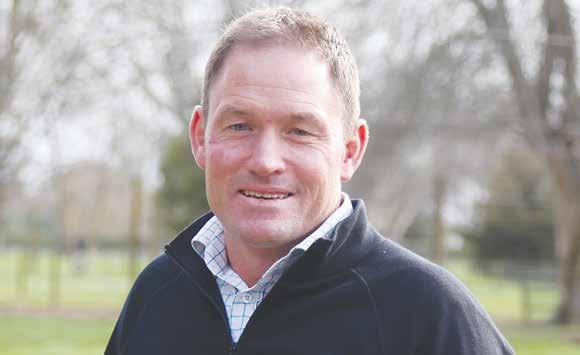
Ellis says it’s unlikely the interim numbers for this year will change much, although there is a possibility there will be some very late calvers.
But the problems don’t end with the loss of milk production – it’s the flow-on effects of the higher than normal empty rate right across the meat and dairy sectors.
“As a result of this, freezing works are very concerned at this because
that extra 1% of empty cows on a 4.8 million cow population means that potentially an additional 48,000 empty cows will be heading to the works.
Sure, there will be some empty cows retained by farmers, but the point is, this will put a challenge on meat works and also the seasonal supply and demand on the meat schedule,” he says.

Ellis says that combined with the nervousness of a lower milk price, the empty rate will add to the woes of farmers. He says in light of this, he predicts many farmers will ‘milk deep’ this season given that grass covers are good and the weather favorable.
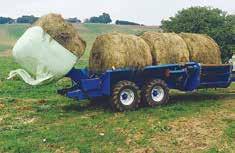
As for the reasons for the higher
than normal empty rate, Ellis says the weather last year was certainly a contributing factor.
“Also, I think there was a lot of farmer fatigue going into the winter and spring.
“You don’t have to be much off your game to make slightly poorer farm management decisions. We do know there was a genuine skill shortage on-farm and we often had quite junior people making strategic decisions at key times of the year,” he says.
Ellis says the interim figures represent the typical bell shaped curve, which means there are farmers with tremendous reproduction but there are also some that are well below the average.
DAIRY NEWS APRIL 18, 2023 NEWS // 3
Bale machine cuts feeding time. PG.20
Dairy sector shows resilience. PG.05
NEWS 3-11 OPINION ............................................. 12-13 MANAGEMENT 14-15 ANIMAL HEALTH 16-17 FEEDING OUT 18-21 MACHINERY & PRODUCTS ........................................ 22-23
DairyNZ Farmers’ Forum registration open. PG.15
PETER BURKE peterb@ruralnews.co.nz
LIC’s general manager New Zealand markets Malcolm Ellis believes the writing was on the wall last year when their data revealed that the national submission rate was down by 1.3%.
A ray of hope for dairying
of this year,” she says.
A GLIMMER of hope for the country’s dairy farmers under siege from a myriad negative challenges including rising input costs, interest rates, state-sponsored regulations and falling commodity prices.
Rabobank senior agri analyst, Emma Higgins told Dairy News that it appears there may be some sort of silver lining coming up later this year and into next year.
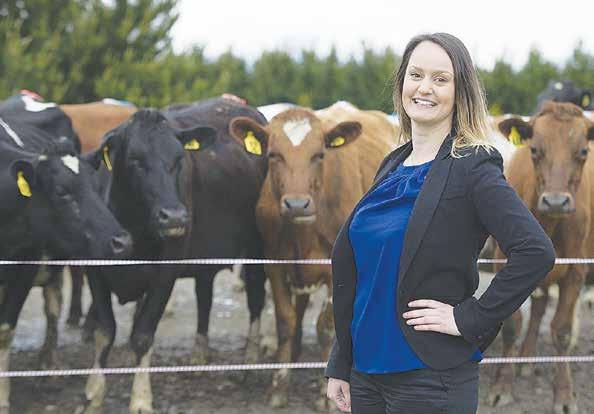
Her remarks breathe some hope into a situation where a recent survey by the bank shows that dairy farm-
ers are more pessimistic than ever about the broader agri economy. Higgins says it’s not just the high-level issues that are affecting dairy farmer morale, but also the problems they are encountering on their farms such as labour issues and adverse weather events.
But Higgins says there are signs of better things to come.
FARM BUDGETS STRETCHED
FEDERATED FARMERS dairy chair Richard McIntyre, who sharemilks in the Horowhenua, says the past year has not been easy.
He says interest rates, rising costs and a lower milk price is stretching farmers’ budgets to the limit. He says the first six months of this season were terrible, but a good summer
and autumn have seen things pick up. He says getting maize planted was a challenge but says the yield appears to be good, despite the late planting.
McIntyre was one of a few farmers who took a punt and spent extra money and bought supplement specifically to get his cows in good condition for mating and this has worked out
well for him. But for him and others, the shortage of skilled labour remains a big problem and one that is not just confined to the farm.
“A lot of our support industries are also shorted staffed, for example, the people who service tractors. Some are little less experienced than in the past and so things aren’t

running efficiently on farm because it’s hard to get your tractors fixed. It costs more to do it and it takes longer because there is a shortage of mechanics,” he says.
McIntyre says farmers are also concerned about killing space at the works, not only for cull cows but also bobby calves.
“I think what we are potentially going to see is more positive margins for dairy farmers in the new season, such as respite on the farm input cost side of things. We are seeing, for example, fertiliser prices lower in response to global benchmark prices and we are expecting to see improved commodity prices come through in the second half
FARMER SENTIMENT BOUNCING BACK
AFTER DROPPING to an historic low in late 2022, New Zealand farmer sentiment has now crept higher, the first quarterly Rabobank Rural Confidence Survey of the year has found. However, rural confidence remains deep in negative territory overall with only one in 20 farmers holding an
optimistic view on the prospects for the agricultural economy in the year ahead.
The latest survey — completed late last month — found farmer confidence was up on the previous quarter (Dec 2022), with the net confidence reading rising to -58%, from -71% pre-
viously. The latest survey found the number of farmers expecting conditions in the agricultural economy to improve in the coming 12 months had risen to 5% (from 4% in the previous quarter) while the percentage expecting conditions to worsen fell to 63% (down from 75%). A total of 31% were
anticipating the agricultural economy to remain stable (up from 19% previously).
Rabobank New Zealand chief executive Todd Charteris said the uptick in confidence came despite incredibly challenging climatic conditions for many of New Zealand’s primary pro-
Higgins says there are signs of demand coming from China, but the hope is that overall demand for dairy products will increase as well. But she adds that there are still some potential challenges ahead with NZ, Europe and the USA increasing their milk production.
“What we are seeing out of the northern hemisphere is that they are moving towards their season milk curve so they are really starting to hit their straps over the coming weeks. As a result, we are seeing some improved milk production come out of the EU and the US and so any surplus milk could add pressure on global dairy prices,” she says.
The other side of the equation is that grain prices may continue to rise due to the war in Ukraine and that will affect input costs in Europe. But while there is potentially some good news on the horizon, dairy farmers remain down in the dumps, and it will take more good news to lift their morale.
ducers during the early part of 2023.
“With Cyclone Gabrielle battering much of the North Island in February, and parts of the lower South Island impacted by drought in recent months, it really has been a tough start to the year for the country’s farmers and growers,” he said.
DAIRY NEWS APRIL 18, 2023 4 // NEWS
PETER BURKE peterb@ruralnews.co.nz
“We are expecting to see improved commodity prices come through in the second half of this year.”
*Offer ends 31/7/23 or while stocks last. Offer only available at participating Polaris Dealers. Not valid with any other offer. Excludes fleet clients. +Finance offer is only available on selected models. GST registered customers only. 24-month term contract. 20% Deposit required. Deposit may include Trade (Trade conditions apply). Fees and conditions apply (normal lending criteria applies) Finance is provided by Polaris Finance, a program operated by De Lage Landen Limited Company No 135515. 6.99% FINANCE P.A+ UP TO $2,500 FREE ACCESSORIES^ ARE ON NOW DON’T MISS OUT, CONTACT YOUR LOCAL POLARIS DEALER TODAY! 0800 440 290 | www.polarisnewzealand.com | /PolarisNZ | /polarisorv_nz FIELD DAY SPECIALS
Rabobank senior agri analyst, Emma Higgins says there are signs of better things to come.
Dairy sector shows resilience
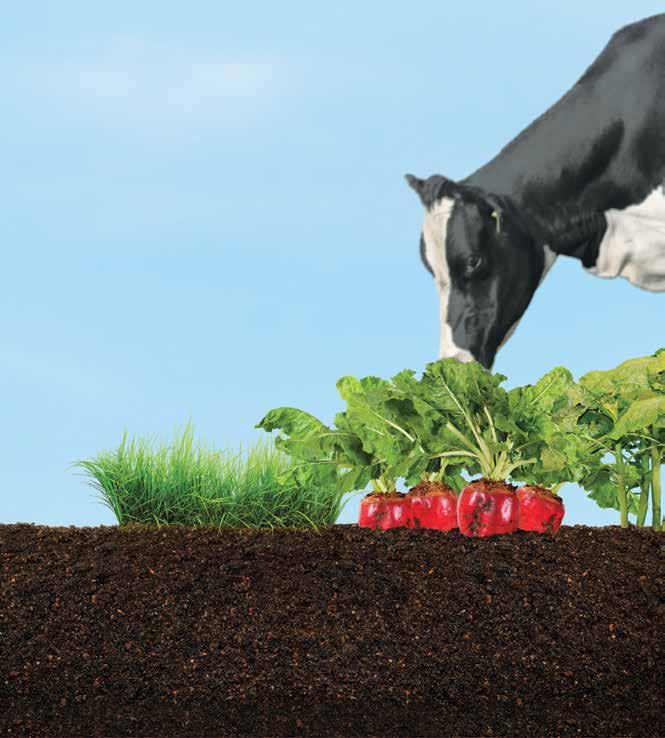
DESPITE A challenging 2021-22 season, the annual New Zealand Dairy Statistics report shows an innovative dairy sector responding well during a changeable time.
Released today by DairyNZ and Livestock Improvement Corporation, the report shows that in the 2021-22 season, 20.78 billion litres of milk containing 1.87 billion kgMS was processed by dairy companies.
After reaching a record milk production per herd and per cow in the previous 2020/21 season, production dropped back to 2019/20 levels as the impacts of Covid-19, climatic conditions on farm, inflationary pressures and supply chain issues presented a challenging year for the industry.
The trend of declining cow and herd num-
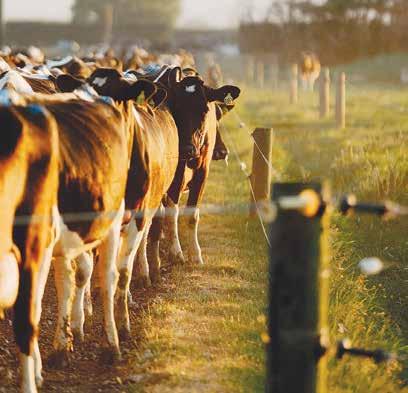
bers continued and was accompanied by a 4.3% decrease in litres and 4.1% decrease in kilograms of milksolids processed, compared to the previous season.
DairyNZ chief executive Dr Tim Mackle acknowledges that farmers’ achievements in the face of a range of challenges in recent years is positive.
“Through tough times farmers continue to prove their resilience and stay focused on milking better and more efficient cows, by making the most of technology and information,” says Mackle.
“Dairy farmers are proud to be world leading and work hard to retain their unique pasturebased farm system, as they keep milk production flowing and therefore creating real value for New
Zealanders.”
The season saw an increased uptake of herd improvement services, with record herd testing levels of 3.79 million
Key statistics
■ The dairy sector produced 20.78 billion litres of milk containing 1.87 billion kgMS – a 4.3% (~929 million litres) decrease in litres and a 4.1% (~79 million kg) decrease in milksolids processed compared with the previous season.
■ Average milk production per cow was 386 kgMS (made up of 216kg milkfat and 169kg protein), a 2.9% decrease from 397kg last season and back to similar levels as 2019/20 season.
■ Cow numbers have continued to decline, down to 4.84 million, a decrease of 1.26% from the previous season.
■ A total of 3.79 million cows were herd tested (78.3% of cows) – a new record.
■ 3.942 million cows were mated to artificial breeding.
cows. Artificial insemination remained steady at 3.94 million cows.
This continues the trend of New Zealand farmers remaining
■ The average dairy co-operative payout of $9.52/kgMS was the highest average payout on record, increasing from $7.76 in the previous season.
focused on improving the production efficiency of their herds, and utilising data and insights to sup-
port on-farm decisions.
LIC chief executive David Chin says New Zealand farmers responded
well to the challenges of the 2021-22 season.
“Rising to challenges in a changing world is nothing new for our sector. Our farmers continue to invest in solutions that will support them to remain global dairy sector leaders.
“Record levels of herd testing uptake and strong investment in artificial breeding demonstrates a continued focus from farmers on herd improvement, to identify poor performing cows and to breed more efficient animals.”
The average dairy cooperative payout from Fonterra and Tatua was $9.52/kgMS, which was a record average payout for farmers, while dairy exports reached a record $22 billion in 2021/22.
@dairy_news
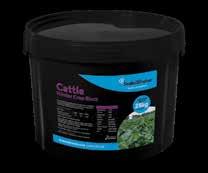
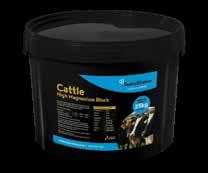
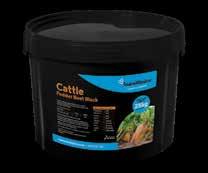
DAIRY NEWS APRIL 18, 2023 NEWS // 5
facebook.com/dairynews
Green grass ‘hiding reality’
there are options to bring in feed and take other steps to mitigate the problems.
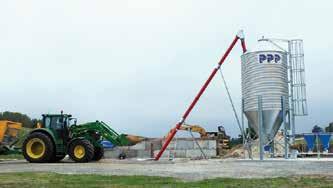
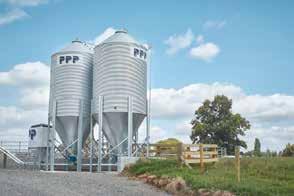
IT LOOKS good physically on farm but below the surface things are far from ideal.
That’s the view of DairyNZ’s farm performance manager, Sarah Speight, who says in general if one looks at pasture covers, cow condition and milk production, things aren’t too bad.
She says this is amazing given the season has been all over the place with adverse weather events which have made it hard for farmers to manage their operations.
Sarah Speight says most of the maize silage has now been harvested, although yields are below last year’s levels.
“But it’s not as bad as originally thought,” she
told Dairy News “There have been problems with pests and the weather has delayed the planting of maize. In one case, a farmer told me he had to plant his crop three times because the weather wiped out the first two plantings,” she says.
Speight says in the upper North Island the
cyclones which brought heavy rainfall had a bizarre positive effect by enhancing grass growth, meaning some extra grass silage could be harvested.
She says there will be challenges in Otago, which has been hit by a drought and there may be a shortage of grass for the cows, but the South Island is pretty big and
In Northland, Hawke’s Bay and the East Coast of the North Island, infrastructure remains a problem with some farms still without road access. She says the bridge at Patoka in Hawke’s Bay has been replaced, enabling stock access and milk collection, but other places are still cut off.
“Farmers in Northland are getting back on track with regrassing taking place and autumn calving progressing well.
“It’s much the same on the West Coast of the South Island where things are looking up in terms of the farm, but it’s financial issues and concern about rising costs that are causing the angst,” she says.
MYRIAD OF CHALLENGES FOR FARMERS, WORKERS
WHILE THE grass is green on the country’s dairy farms, the owners and workers are facing a myriad of challenges.
The 20 cent drop in Fonterra’s milk price forecast is one issue and there is also a much higher than normal empty rate in cows.
DairyNZ general manager farm performance Sarah Speight says the present disruptions and challenges are the new norm and most of the issues are beyond the control of farmers.

“Things like the fact that we have had ongoing issues attracting staff, the pace of government regulation and the rhetoric around that and
impacts of inflation.
“Interest rate hikes have been a big concern for a number of farmers, especially those carrying a reasonable amount of debt, and add to that volatile weather in the last year. Some farmers are working harder than ever and feel they can’t catch a break as it’s been one thing after another,” she says.
Sarah Speight says in the current climate, some farmers are thinking seriously about how long they want to remain in the industry – especially those who are in or nearing their sixties. She says conversely others are focused on seeing what new opportunities may open for them.
She points out there are many pathways whereby dairy farmers can move ‘out of the shed’ by employing a sharemilker, contract milker or variable other sharemilker.
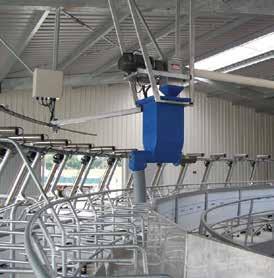
For those that see opportunities in the new environment, Speight says they should be looking at their cash position and their budgets for next season and make sure they are farming within their means. She says to capitalise on new ventures, they need to make sure they have good support around them.
For the likes of share or contract milkers looking at taking on a new venture, they should get good advice because they too will be under infla-
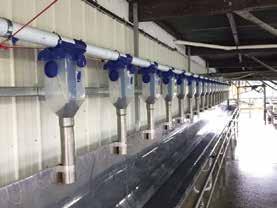
tionary pressure.
“At DairyNZ we have a very strong economics team and on our website we have got some updated budget forecasts for next year for a range of different farms. As well, two of our staff have put together a contract milking calculator so that if people are looking at contract milking rates, they can actually calculate what is the right rate to pay a contract milker.
“This information has been very well received and we have also been doing some workshops to talk people through this information,” she says.
As the year progresses, farmers face the uncertainty of the global economic crisis and economic pressures
at home, one senses there is a feeling of helplessness about what to do.
Sarah Speight says in the circumstances, DairyNZ is doing everything it can to support farmers and ensure that whatever policy changes government make are workable at a farm level. She says it’s impossible to say if political change will see any major policy shifts. She if farmers feel unhappy with the direction of travel then it is up to them to exercise their democratic rights.
“The biggest problem we have in society is apathy when it comes to voting,” she says. – Peter Burke
@dairy_news
facebook.com/dairynews
DAIRY NEWS APRIL 18, 2023 6 // NEWS
PETER BURKE peterb@ruralnews.co.nz
“Farmers in Northland are getting back on track with regrassing taking place and autumn calving progressing well. It’s much the same on the West Coast of the South Island where things are looking up in terms of the farm, but it’s financial issues and concern about rising costs that are causing the angst.”
DairyNZ’s farm performance manager, Sarah Speight says while pasture covers look great, farmers face a myriad of challenges.
Fonterra Dairy Woman of the Year finalists announced
A councillor, an assistant manager, someone who trademarked the word ‘farmily’, and an industry stalwart are among the finalists for this year’s Fonterra Dairy Woman of the Year title. The award is designed to recognise an outstanding woman who has contributed to the dairy sector with passion, drive, innovation, and leadership. Dairy Women’s Network (DWN) trustee Donna Smit says each woman brings “incredible passion, knowledge, leadership and mana to the sector”. Jessica Marshall profiles the four finalists.
sional development programme, or professional/business coaching or learning experience.
The award will be presented later this year at the Gala dinner of the DWN 2023 Conference, which is themed “Brighter, Braver, Bolder”.
Kimberly Crewther
KIMBERLY CREWTHER
is the award’s first-ever off-farm finalist.
She is perhaps best known for her work as executive director of the Dairy Companies Association of New Zealand (DCANZ).
Donna Cram
DONNA CRAM was elected to the Taranaki Regional Council in last year’s local body election, running on a platform of sustainability and proven leadership.
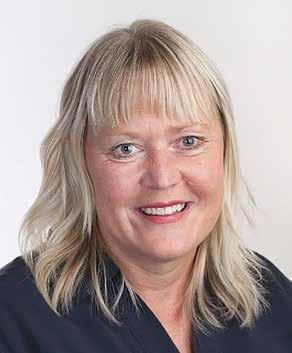
She and husband Philip have farmed at their Awatuna farm, Wylam Dene, for close to 23 years, milking 280 cows.
In 2016, the pair won the Fonterra Environmental Leadership in Dairy Farming award at the Taranaki Regional Council Awards.
In 2021, Cram graduated from the Agri-Women’s Development Trust (AWDT) Escalator programme. The programme is designed to give women the mindsets, skills and connections to create systemic change in agriculture and rural communities.
That same year, her farm was among the finalists for the Fonterra Responsible Dairy Award.
Cram is chair of Taranaki Catchment Communities which seeks to “lead, engage, and mobilise the Taranaki rural sector the region’s rural sector to ensure a more environmental, economic, and socially sus-

tainable future”.
She is also a DairyNZ Dairy Environment Leader (DEL), a member of the Taranaki Federated Farmers Dairy committee, and trustee for Dairy Trust Taranaki.
Cram is a lifelong
In that role, Crewther has advocated for the industry around issues relating to the Government’s emissions pricing framework, and the two recent free trade agreements (FTAs) with both the United Kingdom and
within Fonterra and was a trade policy analyst for Meat New Zealand.
Currently, she chairs the member reference and funders groups for the Biodiversity Business Pledge, a partnership that aims to help Kiwi businesses take a proactive approach to their biodiversity practices.
Crewther is also a board member on the
She was named a finalist for the award in 2021 but lost out to Whanganui sharemilker Belinda Price.
At the time, DWN trustee and awards judge Sophie Stanley said “positivity, enthusiasm and holistic approach to farming and family life shine through her nomination”.
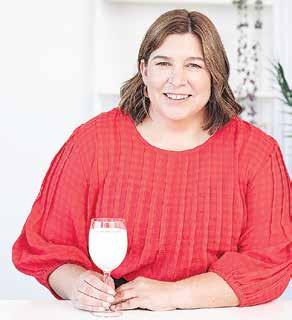
She is part of the Farming Families Charitable Trust events team
learner, with a passion for connecting people, bringing new people to the industry, a focus on the environment and how the industry can continue to produce good food in a sustainable way.
The recipient of the award will receive a scholarship of up to $20,000 for an approved and personally chosen profes-
the European Union.
When the former was first introduced, Crewther said it would be counterproductive, claiming the emissions proposal held a significant risk of leakage.
Prior to that, Crewther spent just over a year working for DairyNZ as its general manager –policy & advocacy.
She held multiple roles
New Zealand International Business Forum, and represents dairy companies in the Government and Industry Agreement for Biosecurity Readiness and Response, and is a member of the New Zealand National Committee for the International Dairy Federation.
Rebecca Miller
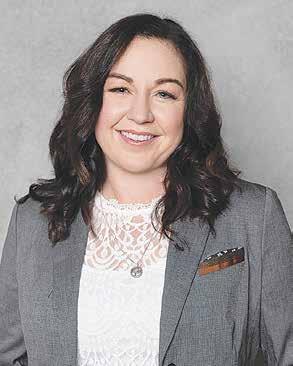
REBECCA MILLER has been dairy farming all her life.
Currently, she has an Equity and Share Farming business across two farms in Ashburton.
Two years ago, in 2021, Miller won the Emerging Leader award for Canterbury at the Champion Canterbury Awards.
That same year, she and partner Brent were nominated for the Employee Development category at the Ministry for Primary Industries’ (MPI’s) Good Employer Awards.
This marks the second time Miller has been a finalist for the Dairy Woman of the Year award.
and the AWDT mentoring programme.
Last year, she and her partner trademarked the word ‘Farmily’ to describe the interpersonal relational connection developed on farm, as a living philosophy of kindness, maturity, and responsiveness.
Sheena Penwarden
SHEENA PENWARDEN is assistant manager Whananaki Farms and the operations manager for Te runanga o te rarawa.
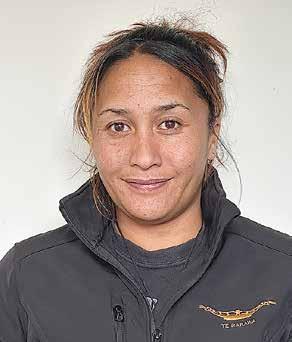
She is also the freshwater environmentalist representative for the 23 Marae of te rarawa.
In 2020, Penwarden was named Northland Dairy Manager of the Year.
“Sheena is driven by Maori values, passionate about educating her com munity on dairy and the environment,” says DWN trustee Donna Smit.
She supports hapu by taking their aspira tions and helping to edu cate them with modern
and western science to develop and understand the importance of improvement within their area.
Penwarden is also actively involved in the Breast Cancer Foundation NZ, volunteering for the organisation.
Fully Escorted Tours

2023
Rarotonga Relaxer - 17 May*
8 days tropical Cook Islands, beachfront
Vivid Sydney - 25 May
5 days Vivid Festival ,Tina The Musical
Sunshine Coast - 13 Jun*
8 day Winter Sun, Coast & Mountains
Cairns & Port Douglas - 6 Aug
12 days Barrier Reef, Fitzroy Island
Canada & Alaska - 13 Sep
21 days Rocky Mountaineer & Cruise
Southern Africa - 17 Sep
20 days Wildlife, Victoria Falls, Botswana
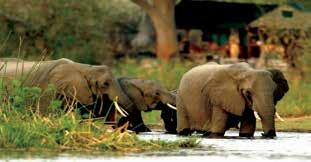
Perth Wildflowers - 12 Oct
11 days Spectacular Wildflower Festival
Tasmania Spring - 2 Nov
11 days Wild Beauty of Tasmania
* $250 per person off Rarotonga & Sunshine Coast until sold out. (Offer is not combinable).
DAIRY NEWS APRIL 18, 2023 NEWS // 7
Donna Cram
Kimberly Crewther
Rebecca Miller
Sheena Penwarden
Family fun day at Owl Farm
MORE THAN 650 people attended the Owl Farm open day at St Peter’s School in Cambridge earlier this month.
The demonstration farm, which provides opportunities for students to learn more about dairy farming and showcases
the sector to the wider public, has welcomed more than 10,500 visitors since inception in 2014.

The open day was a
fun family day, with a milking demonstration in the rotary shed, a wetland tour and fun kids’ activities including sitting in a
milk tanker and tractor.
DairyNZ is one of the Owl Farm partners –Rosie the Cowbassador was on DairyNZ’s stand at
the open day, representing New Zealand’s dairy cows and telling the dairy farming story to children.
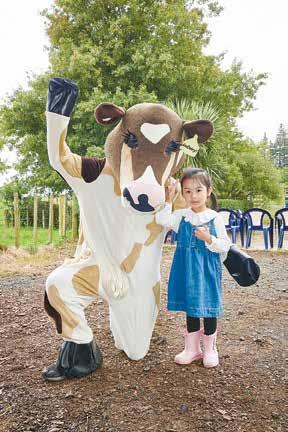
DairyNZ education & community engagement manager Phillipa Adam says the Owl Farm open day was a great opportunity to show families a slice of dairy farming life.
“The dairy sector is always looking to attract more people to the sector,” says Adam.

“About 37,000 people work on dairy farms throughout New Zealand, looking after our cows and helping create the milk and dairy products Kiwis love.”
Another key goal of Owl Farm is demonstrating excellence in farm performance to contribute to a sustainable future.
DairyNZ is a partner in Owl Farm – created by St Peter’s School and Lincoln University. Other partners include Ballance, Farm Source, PGG Wrightson Seeds and Westpac.
Adam says DairyNZ’s involvement in Owl Farm
is part of its broader education programme, which teaches young New Zealanders about dairy farming.

“In addition to Rosie’s World, we organise visits to dairy farms for schoolchildren. This includes showing young people the work farmers are doing to reduce footprint, including riparian planting and restoring wetlands.
“DairyNZ creates inschool science resource kits aligned to the NZ curriculum. These kits support schools to teach curriculum-based subjects such as science and maths within a unique dairying context.”


Owl Farm is home to 350 cows. Dairy is NZ’s largest export, providing nutritious food for families and contributing to the economy and local Kiwi communities.
New Zealand produces 225 million servings of milk a year. One glass of milk provides 30% of the daily calcium growing kids need to develop healthy teeth and bones.
DAIRY NEWS APRIL 18, 2023 8 // NEWS
NOW
ONLINE READING THE PAPER ONLINE HAS NEVER BEEN EASIER ■ BREAKING NEWS ■ MACHINERY REVIEWS ■ MARKETS & TRENDS ■ MANAGEMENT STORIES ■ COMPETITIONS ■ AND MUCH MORE... All the latest stories and more at www.dairynews.co.nz
A young visitor befriends DairyNZ’s Rosie the Cowbassador at the Owl Farm open day.
READ IT
Farmers, Govt launch JV to help pastoral sector reduce
FARMERS AND the Government have jointly set up an investment fund to help the pastoral sector reduce emissions.
The Centre for Climate Action joint venture aims to help pasture-based farmers reduce their agricultural emissions by 30% by 2030.
As its first investment, the centre is pouring $1.8 million into Ruminant BioTech, a New Zealand-based start-up that is developing a slow-release, biodegradable methaneinhibiting bolus.
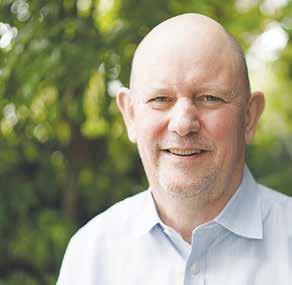
Initial trials are promising, indicating the bolus could deliver significant reductions in methane emissions from pasturebased farming, with trials indicating potential for reducing methane emissions by up to 70% for up to six months.
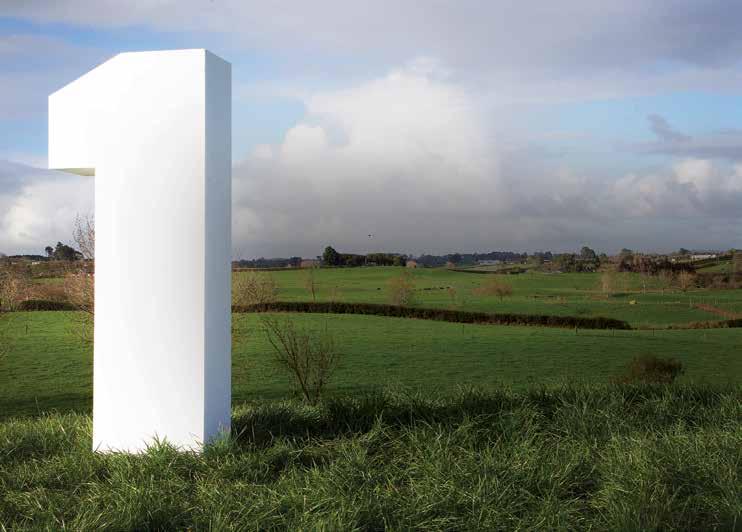
Centre executive director Wayne McNee notes that almost half of New Zealand’s greenhouse gas emissions come from agriculture, which makes up 75% of New Zealand’s goods exports.
“Since agriculture is the backbone of New Zealand’s economy, the importance of reducing methane emissions in agriculture cannot be understated.
“Our global customers are setting ambitious greenhouse gas reduction targets, and if we can’t meet these targets, export revenue that has underpinned our living standards will be under threat. We must confront this reality, and I believe we can meet the challenge.
“We’re focused on scaling up efforts made to date by Kiwi farmers and agri-researchers and forging ahead with investigating new opportunities and investments.
“We welcome interest from potential new shareholders, technology companies and strategic partners.”

Established in February, the centre is a worldfirst investment fund established between Government and major agri-
business companies to help pasture-based farmers in Aotearoa New Zealand reduce their agricultural emissions by 30% by 2030.
The joint venture’s role is to help take the pressure off New Zealand farmers by making sure that they have equitable access to affordable and effective tools and technology to cut their methane and nitrous oxide emissions, while maintaining efficiency, production and profitability.
The JV’s shareholders are ANZCO Foods, Fonterra, Rabobank, Ravensdown, Silver Fern Farms and Synlait, many of the largest players in New Zealand agribusiness owning 50%, with the other 50% owned by the Government through MPI.
The board is chaired by Sir Brian Roche and includes Jessie Chan, Sir Neville Jordan, Greg Murison and Fraser Whineray, who bring experience in agribusiness, agri-research and tech start-ups. McNee says the JV is focused on getting tools into farmers’ hands and brings together large agriculture players with expertise and capital in a way that’s never been seen before in New Zealand or anywhere else in the world.
“The JV’s shareholders have access to over 70% of New Zealand’s farms which will make it easier to accelerate the adoption of emissions reduction tools on farm.
“Our shareholders are committed to ensuring the JV is commercially led, informed by science, and investing in and developing practical tools to reduce agricultural emissions. We also recognise the importance of intergenerational stewardship of the land and the key role te ao Māori beliefs, values and aspirations will play in the success of the JV.
“The JV must be a problem solver and value creator. Our sharehold-
ers have invested in the JV because it is working to solve the emissions challenge for our
pasture-based farmers, and because it has potential to be the world leader in commercialising emis-
sions-reduction solutions for pasture-based farmers that can be sold in New Zealand and globally.”
1

DAIRY NEWS APRIL 18, 2023 NEWS // 9
Centre for Climate Action director Wayne McNee says they are focused on scaling up efforts made to date by Kiwi farmers and agri-researcher.
emissions
of a kind. makes a lot of cents. Eprinex is not only the 1 and only drench to have worldwide NIL milk withholding when treating lactating cows - it is also the No.1 drench for
on investment by far. For example, based on an average herd
of 500 cows and a $9.00 payout,
can expect a return of $67.44 per cow. Eprinex makes a lot of sense… and cents. For more info go to futureproducers.co.nz BO1387 Scan here to calculate the R.O.I. on your herd... Based on a 500 cow herd and $9.00 milk solid payout. $ 67.44 PER COW* Typical R.O.I. by using Eprinex® on your dairy herd this season. PROUDLY AVAILABLE FROM YOUR LOCAL PARTICIPATING VETERINARY CLINIC Boehringer Ingelheim Animal Health New Zealand Limited. Level 3, 2 Osterley Way, Manukau, Auckland, New Zealand. EPRINEX® is a registered trademark of Boehringer Ingelheim Vetmedica GmbH, used under licence. Registered pursuant to the ACVM Act 1997, No. A007191. © Copyright 2021 Boehringer Ingelheim Animal Health New Zealand Limited. All rights reserved. NZ-BOV-0012-2022. futureproducers.co.nz Ensure young stock become future high producers through improved health, growth and energy at: Together going forward.
return
size
farmers
Ballance CEO to step down
FARM NUTRIENT cooperative Ballance Agri Nutrients is on the hunt for a new chief executive.

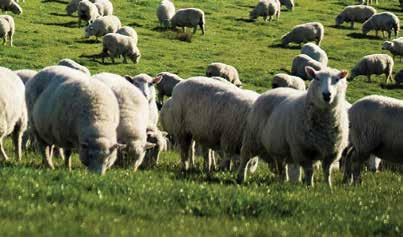
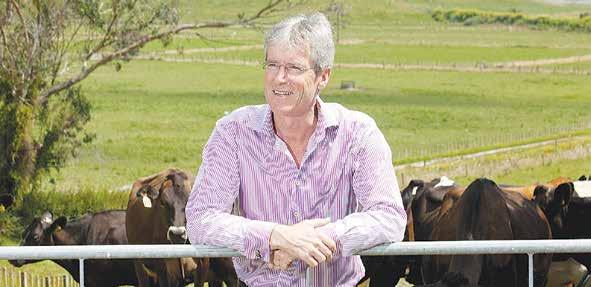
After nearly nine years in the role, current chief executive Mark Wynne
has announced that he will leave the co-op at the end of September.
Ballance chair Duncan Coull says supporting and maintaining Ballance’s fantastic culture will be
top of mind in the board’s search for a new leader.
Coull says Wynne will remain in the role until a replacement is found.
“Mark will carry on doing what he does best,
After nearly nine
in
TO ALL FARMERS. FOR ALL FARMERS.
leading a great team to ensure we are providing New Zealand farmers and growers with the nutrients, advice, and the tools they need to continue to be the most productive and sustainable farmers and growers in the world,” says Coull.
He says Wynne is held in high regard by the Ballance board.
“When Mark informed the board of his intention to resign, he told us what a privilege it has been for him to lead such an awesome group of people serving 17,000 farmer and grower families.”
Wynne says it has been an amazing and incredibly rewarding experience to lead such a diverse business and dedicated team.
CREAM OF THE CROP
THE THIRTY finalists representing 11 regions in the 2023 New Zealand Dairy Industry Awards have been found.
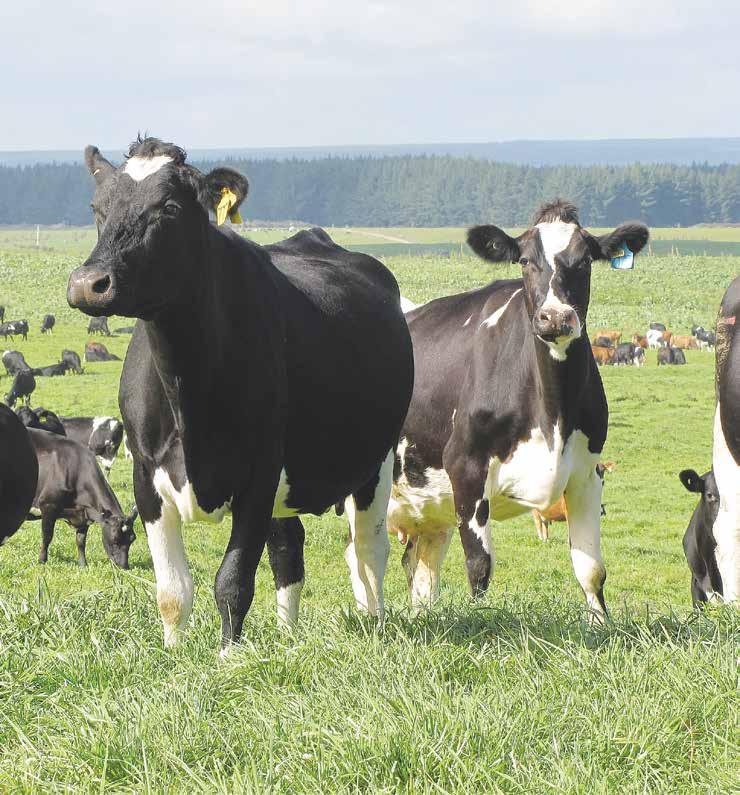
The group will now compete for national titles in the three categories: Share Farmer of the Year, Dairy Manager of the Year and Dairy Trainee of the Year. NZDIA general manager Robin Congdon says it was fantastic to attend the regional dinners and feel the excitement of the wins and see the journey each finalist has taken, both professionally and personally.
He observed women featured strongly in the dairy trainee category, with eight of the eleven regions won by females.
“Our finalists are farmers who are excited by the use of technology in the dairy industry and how it will benefit farming in the future.
“They are young, progressive farmers who aren’t afraid of change, are focused on sustainability and hold a deep respect for the environment along with a strong desire to protect it for future generations.
“Our national finalists come from all walks of life and we have noticed this year that many are keen to be part of the solution regarding bobby calf numbers moving forward.”
Winners will be announced at a black tie awards dinner at Cordis Hotel in Auckland on Saturday 13th May, after the finalists complete a final round of judging.
The finalists will compete for a total prize pool worth around $200,000.
The New Zealand Dairy Industry Awards are supported by national sponsors DeLaval, Ecolab, Federated Farmers, Fonterra, Honda, LIC, Meridian, Ravensdown, and Trelleborg, along with industry partners DairyNZ, MediaWorks and Rural Training Solutions NZ.

DAIRY NEWS APRIL 18, 2023 10 // NEWS
years
the role, Ballance chief executive Mark Wynne will leave the co-op at the end of September.
www.ruralnewsgroup.co.nz
HORTNEWS RURAL NEWS TO ALL FARMERS, FOR ALL FARMERS
Oz supermarket giant buys milk plants as supply concerns linger
ing the milk with third parties.
AUSTRALIAN SUPERMARKET giant Coles’ foray into milk processing is another sign of concern over milk security, says Australian dairy analyst Steve Spencer, Freshagenda.
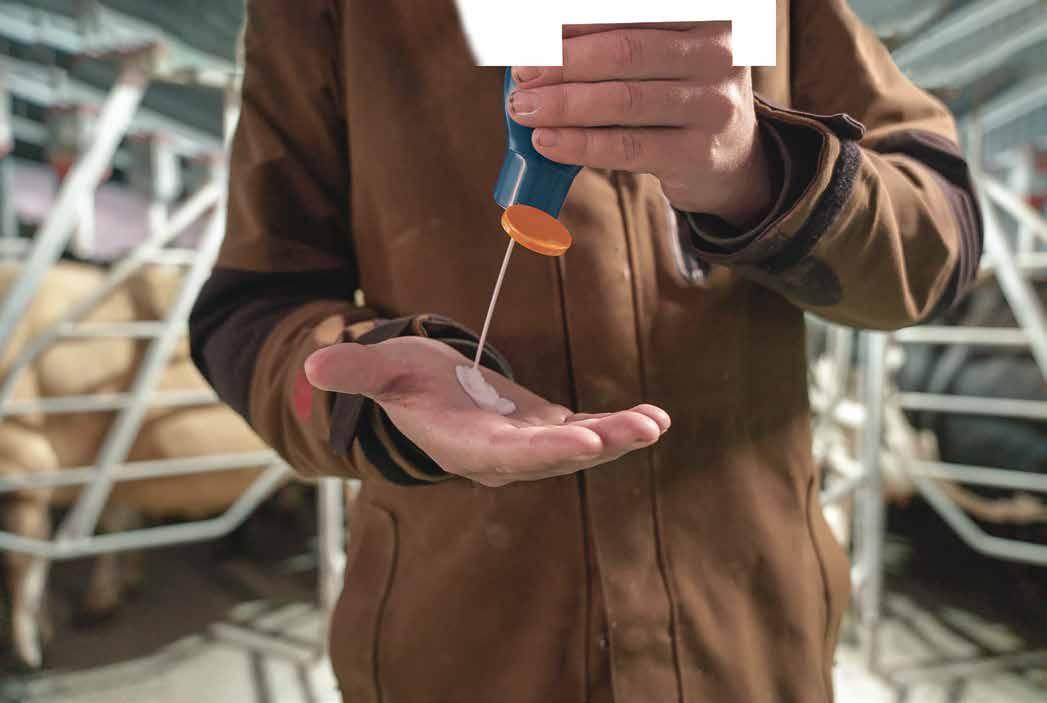
Spencer told Dairy News that Australian milk supply continues to fall and domestic buyers are worried.
Coles is paying A$105 million for two milk plants owned by Saputo Dairy Australia (SDA). One of Australia’s two major grocery chains, Coles, has been buying milk directly from farmers since 2019 and process-
Spencer describes Coles’ decision to invest in processing plants as a major development.
“It is another sign of the deeper concern over milk security by domestic buyers, as the national milk production keeps falling.”
Spencer doesn’t expect the deal to impact either milk payouts to farmers or Fonterra, which operates milk plants in Victoria and Tasmania and processes milk for the other major retailer Woolworths.
Spencer doesn’t expect Woolworths to buy processing plants, not in the short term at least.
“Woolworths, as yet,
don’t buy much milk directly from farms but that may change as it gets harder to secure milk.”
In a statement Coles says the two processing facilities – at Laverton North, Victoria and Erskine Park, NSW, can pro-
cess around 225 million litres a year. They are predominantly used today to process Coles Own Brand 2L and 3L milk.
Coles chief executive Steven Cain says the acquisition builds on the strong relationships it
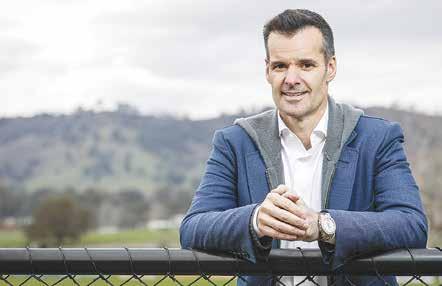
has developed with dairy farmers since 2019.
“While improving security of our milk supply and our supply chain resilience in the dairy sector, these facilities also have sufficient capacity to facilitate fur-
ther growth opportunities through new product innovation.
“The acquisition will build on the strong relationships we have developed with our dairy farmers since launching our direct sourcing model in 2019.”
Around 90 dairy farmers supply milk direct to Coles, allowing these farmers to invest for the future and ensuring the long-term sustainability of their farms.
“These processing facilities will complement our existing investments in our Own and Exclusive brand portfolio and manufacturing capabilities in areas such as convenience meals and meat,” says Cain.
Saputo Dairy Australia says as the Australian dairy industry landscape continues to evolve, the sale of the two plants will streamline its manufacturing network and strengthen market competitiveness
“We’re continually working to ensure we have the right manufacturing footprint and product offering to enhance our position as a high-quality, low-cost processor,” said Lino A. Saputo, chair of SDA’s parent company Saputo Inc.
The sites employ approximately 48 people. All employees will receive an offer to transfer their employment to Coles Group Limited.
DAIRY NEWS APRIL 18, 2023 WORLD NEWS // 11
Saputo chair Lino Saputo Junior says it is working on having the right manufatcuring footprint in Australia.
SUDESH KISSUN sudeshk@ruralnews.co.nz
Here we go, again!
ANOTHER REPORT, and yet another feeble attempt by Greenpeace to blame the dairy sector for all water quality issues in New Zealand. This time it’s a Ministry for Environment report released last week which Greenpeace paints as a ‘wake-up call’ for the Government. This activist group seemingly blames dairying for every aspect of environmental degradation. It puts the sole blame on the dairy industry, calling out Fonterra of course, for the state of all rivers, waterways and drinking water. Yet it doesn’t say a word about urban sewage pollution that we know goes into waterways and makes many of New Zealand rivers and beaches unfit to swim, Auckland and Wellington being two obvious examples.
Farmers are doing their best to reduce nutrient leaching. The same can’t be said about many councils.
Anti-cow brigade
Many countries are doing their best to reduce emissions and achieve climate goals, China being an obvious exception. Many countries with sizeable dairy sectors are looking at different tools to reduce methane emissions from cows. In the UK, the Government is proposing giving cows ‘methane blockers’ to reduce their emissions of the greenhouse gas as part of plans to achieve the country’s climate goals. The government said in its net zero growth strategy published recently that it expected “high-efficacy methane-suppressing products” to enter the market from 2025 and could force farmers to use them if they prove effective.
Farmers welcomed the proposal, which follows a consultation that began in August on how new types of animal-feed products can reduce digestive emissions from the animals. However, never satisfied, the anti-cow brigade were sceptical, arguing that the move would not address the other environmental harms resulting from the beef and dairy industries and showed a fixation on “techno fixes” rather than reducing consumption.
Low-emission latte
STAYING ON climate change, forget fair-trade coffee beans and cows’ milk substitutes, low-emission lattes could be the next big thing to land at your local cafe.
A new study in Australia has paved the way for the dairy industry to dramatically slash its methane emissions by feeding cattle with an unlikely additive – a native red seaweed called asparagopsis armata. While the study provides a possible opportunity for dairy farmers to reduce their carbon footprints, it may also kick-start a profitable new “low emissions” marketing avenue for the industry. Published in the March edition of the international journal Animal Feed Science and Technology, the study found that pouring seaweed-infused canola oil over feedlots slashed their methane emissions without impacting the quality or quantity of milk produced.
The species of seaweed added to cattle feed can drastically reduce cows’ burping. Cows consume the seaweed in dried pieces sprinkled on their food or as an oil.
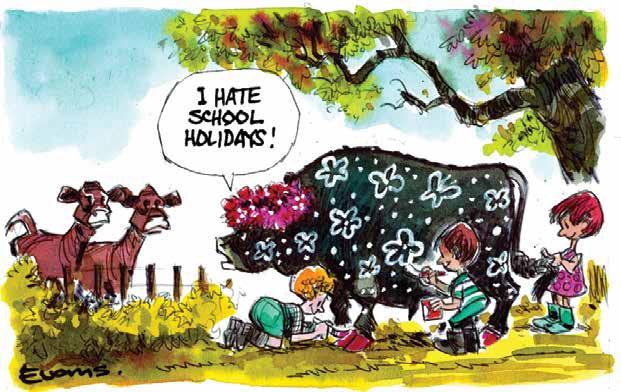
Head Office: Lower Ground Floor, 29 Northcroft St, Takapuna, Auckland 0622 Phone 09-307 0399.
Happy cows, more milk
A UNIVERSITY of Pretoria (UP) study has shown that playing soothing classical music to dairy cows lowers their stress levels and increases their milk production. The findings, which were published in the journal Domestic Animal Endocrinology, are the result of research by Lize-Mari Erasmus, a former member of UP’s Camerata choir, who has a Master of Science (MSc) degree in Agriculture (Animal Science) cum laude from the university.
Erasmus’s MSc studies allowed her to combine her two passions: music and animals. Before embarking on a career in animal sciences, she had obtained a Bachelor of Music degree at UP, with Choral Conducting as one of her majors. Hers is the first study of its kind in South Africa to investigate the influence of classical music on the stress levels and milk production of cows. “The health and welfare of dairy cows go hand in hand with efficient and sustainable dairy production,” she says about the value of providing farm animals with enriching environments.
A single per cent – big difference

NEWS THAT about 17% of the national herd of 4 million cows did not get pregnant and won’t be producing milk in the coming season will come as blow to many farmers and the economy of the country.
While the statistics from LIC are ‘interim’, the reality is the final figures when they do come out will differ little. It will add to a list of challenges already confronting the industry. Fonterra lowered its 2022-23 forecast farmgate milk price by 20c this month, inflation is still rising, as are interest rates, and labour supply and input costs are still an issue.
Arguably farmers should have seen this fertility drop coming, and some did, spending extra cash to get their cows in perfect condition for spring mating.
The weather was unquestionably a problem and many farmers took the risk of milking late into last season. For some, this hasn’t paid off. It was a tough winter and a late spring and balance days were over a week later than normal. In many cases, grass was low in ME.
But the stark reality which has emerged is that, on average, the reproduction performance of the national herd has dropped significantly. This was flagged in late spring when LIC noted that the national submission rate for cows was down by 1.3%. It may not sound much in percentage terms, but the consequences of this will impact on both the meat and dairy sectors, which are intertwined.
If 40,000 plus extra cull cows become destined for the works, can the processors who are already short of labour cope? Will this flood of cull cows impact on the beef schedule and how will that play out in export returns to New Zealand?
The international meat market is already in a fragile state and the operations and marketing staff in the meat companies will be scratching their heads to find a way to deal with this latest challenge.
One could argue that some of the problem was due to farmer fatigue and the lack of quality labour – something incidentally that has affected returns in other primary sectors.
What it does show is that farmers can’t afford to drop their game at any time, regardless of their situation.
Publisher: Brian Hight Ph 09-307 0399
General Manager: Adam Fricker Ph 021-842 226
Editor: Sudesh Kissun Ph 021-963 177
Machinery Editor: Mark Daniel Ph 021-906 723 markd@ruralnews.co.nz
Reporters: Peter Burke Ph 021-224 2184 peterb@ruralnews.co.nz

Subscriptions: Julie Beech Ph 021-190 3144
Production: Dave Ferguson Ph 027-272 5372 Becky Williams Ph 021-100 4831
Digital Strategist: Jessica Marshall Ph 021 0232 6446
DAIRY NEWS APRIL 18, 2023 RUMINATING
MILKING IT... 12 // OPINION
EDITORIAL
Dairy News is published by Rural News Group Limited. All editorial copy and photographs are subject to copyright and may not be reproduced without prior written permission of the publisher. Opinions or comments expressed within this publication are not necessarily those of the staff, management or directors of Rural News Group Limited. Postal Address: PO Box 331100, Takapuna, Auckland 0740 Published by: Rural News Group Printed by: Inkwise NZ Ltd Contacts: Editorial: sudeshk@ruralnews.co.nz Advertising material: davef@ruralnews.co.nz Rural News on-line: www.ruralnews.co.nz Subscriptions: subsrndn@ruralnews.co.nz
SALES REPRESENTATIVE: Lisa Wise Ph 027-369 9218 lisaw@ruralnews.co.nz WELLINGTON SALES REPRESENTATIVE Ron Mackay Ph 021-453 914 ronm@ruralnews.co.nz SOUTH ISLAND SALES REPRESENTATIVE: Kaye Sutherland Ph 021-221 1994 kayes@ruralnews.co.nz • Printed by Inkwise • Distributed by Reachmedia
AUCKLAND SALES REPRESENTATIVE: Stephen Pollard Ph 021-963 166 stephenp@ruralnews.co.nz WAIKATO
New wine in old bottles
aged tremendous market behavioural response and innovation.
nature conservation.
THE RECENT extreme weather events in New Zealand, which included fatalities and significant property damage, including an estimated $1 billion to the agriculture sector alone, should makes us pause and think again of the best way forward for us to make our contribution to the planet’s climate and food needs.
Who remembers acid rain? Not many I bet, because the problem has largely been solved. But at one stage it was considered an even more urgent threat than climate change for those living under its cloud.
How it was solved is instructive and should help us solve the current pressing climate problems – emissions and a shocking loss of global biodiversity.
In New Zealand we are witnessing discontent among pastoral farmers at proposals to essentially tax agriculture’s carbon emissions. We export 97% of our dairy production to global markets while having the lowest carbon footprint in the world. Our meat producers likewise have the lowest greenhouse gas footprints and our pastoral farmers are on a continuous journey to reduce this year by year.
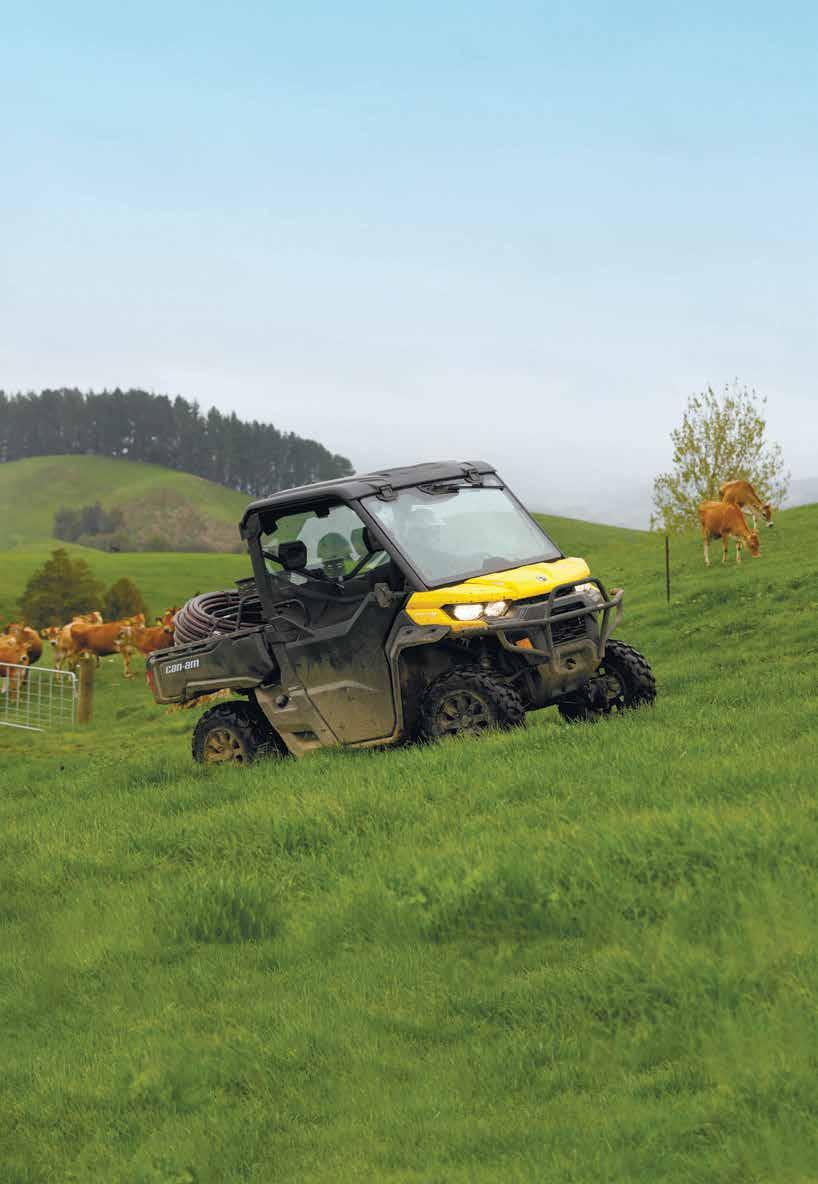
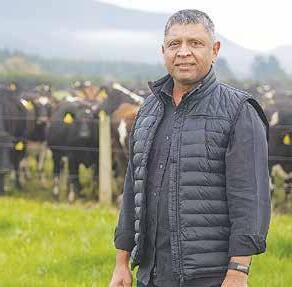
However, half of our national emissions come from agriculture and so we have little choice but to cut farm emissions to help meet New Zealand’s commitment to the Paris Agreement on Climate Change.
In a way these emissions have become the equivalent of our acid rain: an urgent and addressable problem if the solution incentivises the right behaviour.
The issue of industrial air pollutants reacting with water and oxygen to form noxious sulphuric and nitric acid droplets, or “acid rain”, was solved by imposing a cap and trade system on polluting industries.
What’s more, this solution came faster and at a fraction of the fearsome cost originally envisaged, simply because the structure of the system encour-
The current response in New Zealand proposes taxes on emissions which many fear will add up to livelihood-threatening costs over time. The sequestration options conceded are negligible and impractical and will do little to meaningfully modify behaviour.
The plan may only achieve its objective by driving farmers out of the industry altogether, which will in itself cause harm to the country’s well-being, and deprive overseas markets of our wholesome low footprint prod ucts – which will then be replaced by others pro ducing higher emissions options.
This is an own goal for planet earth.
Cap and trade has been staring New Zealand and the world in the face since the days of acid rain. This solution was champi oned by President George H.W. Bush and was devel oped by an “unlikely mix of environmentalists and free-market conservatives”. It is this type of unorthodox thinking that is required to solve the big issues facing us today.
In its most simple form, a cap and trade would see governments set sinking emissions caps. Farmers under the cap would get credits, which those above the cap would have to buy off them. Farmers would also be able to earn ‘biocred its’ for promoting biodi versity and carbon credits for carbon sequestration, including soil carbon sequestration.
This is a particularly appealing solution because it promotes con tinuous virtuous behav ioural change to actively farm in a way that cap tures carbon, promotes biodiversity and reduces emissions.
It provides a direct answer to the two key global ‘COPs’ – Climate Change COP and Biodiversity COP. Climate change is directly related to soil health and loss of biodiversity.
If we are to success fully confront the climate crisis in the long term, we need to encourage native planting wherever it can
be accommodated for the dual purpose of carbon sequestration and biodiversity promotion – even if there is a cost in the short term and a slower rate of sequestration than exotic forests. Biodiversity credits, or ‘biocredits’, are also emerging as a tradeable unit of biodiver-
To simply penalise farmers for outputs is akin to single entry accounting. It is illogical and unfair.
Currently, pastoral farmers only get paid for the products that are sold to processors. A cap and trade system would essen-
entry accounting. It would measure emissions as a cost against revenue for other social goods provided, including carbon sequestration, ecological preservation and biodiversity promotion.
• Prem Maan is executive chairman of Southern Pastures Group which includes
DAIRY NEWS APRIL 18, 2023 OPINION // 13
PREM MAAN
Uni farm promotes more ethical way of dairying
LINCOLN UNIVERSITY has launched a new research venture which aims to lead the way towards a more ethical and sustainable way of dairying.
The Integral Health Dairy Farm is being established across a large portion of the University’s Ashley Dene Research and Development Station at Springston.

The project focuses on “producing healthier dairy products, removing the negative connotations and environmental impact of dairying, providing a positive emotional environment for animals, offering a new range of narratives for the industry and enhancing the sense of belonging to the land”.
The project is led by Professor of Livestock Production Pablo Gregorini, who told a recent open day that the farm aimed to produce “not milk, but health”.
“We are members of nature’s community. What we do to them we do to ourselves, only by nurturing them can we nurture ourselves. Only by healing them can we heal ourselves.”
Gregorini also heads the University’s Pastoral Livestock Production Lab, which has recently released research demon-
strating that cows bred for low-N emissions and fed on diverse pastures produce milk contain-
ing higher levels of substances valuable to human health.
He said there was a
need to re-engage with a society which was looking for changes in production systems and where some people were seeking to live lives absent of animal products.
Gregorini said the project was a collaborative effort with input from universities students and researchers around the world.
The farm’s guiding principles include:
■ PharmEcology – the interactive chemistry of soil, plants and animals
■ Multipurpose adaptive foraging for environmental, animal, human and societal health
■ Functional biodiversity
■ Multifunctional woody vegetation

■ Hedonics and eudemonics – the pleasure and happiness of the animals
■ The gradual replacement of synthetic inputs by ecosystem services
■ Treating animals as sentient beings
■ System digitalisation
■ Healthier milk to the community
To achieve those goals, the farm will feature what they call multipiece adjacent pastures – strips of various forages – and multifunctional browsing sites, in the form of many small blocks of trees, shrubs and herbs giving
cows both shelter and a choice of feed giving both a “hedonic benefit” and self-medication for minor ailments.
Structures will include a sheltering “mootel” and birthing unit.
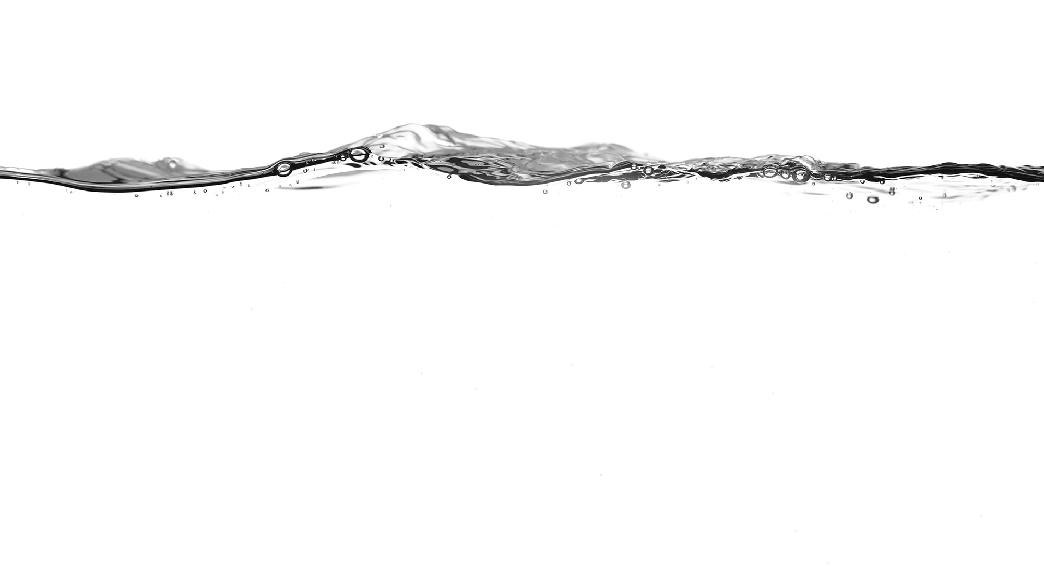
The farm’s research manager, Dr Anita Fleming, said they wanted to bring more biochemical diversity into the pasture system and allow cows to make their own decisions about what to eat.
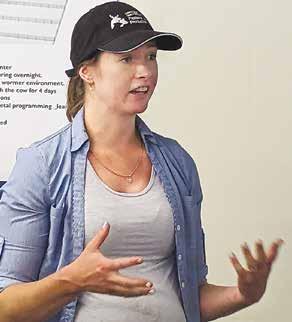
She said cows find it difficult to selectively graze mixed pastures, so they have come up with the concept of adjacent pastures, with strips of different forages that the animals can easily distin-
guish and pick from. Stocked with crossbred cows, the farm would implement a calving system that was less stressful for calves and mothers, and produce an animal that isn’t considered just a by-product.
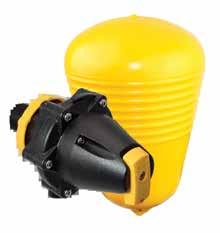
The open day also included presentations from some of the collaborators including suppliers of high-tech monitoring and management systems.
The farm will include what is called Green Artificial Intelligence to constantly measure carbon and greenhouse gas flow in real time.
It also intends using ear tags from Waikatobased ProTag, which monitor all the usual parameters of cows’ vital signs and activity, but in a small solar-powered eartag package without collars or counterweights.
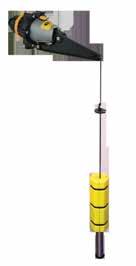
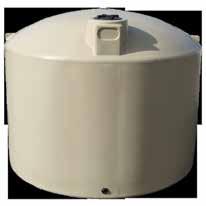
ProTag co-founder Tyrel Glass told the open day that part of the solution to its small size was using a power-saving system in which only a few tags at any time would be communicating whole herd data over signifiant distances. Most ear tags in the herd would be communicating with low power only over short distances to those relays. The method would “smear” power consumption across the entire herd, he said.

DAIRY NEWS APRIL 18, 2023 14 // MANAGEMENT
MALTHUS
NIGEL
Professor of Livestock Production Pablo Gregorini speaking at a recent open day.
0800 JOBE VALVES jobevalves.com • High Flow • Compact/Robust • New Pilot Flow Filter • Side/Bottom Mount • Detach to Clean • Stainless steel bracket and Shaft • Fits plastic and concrete tanks • Rugged and long lasting • For Water Storage Tanks • Adjustable levels from 50mm-2.5m • Minimises pump operation •Available in 20/25/32/50mm
Farm research manager, Dr Anita Fleming said they brought a more biochemical diversity into the pasture system.
Science-based solutions on agenda
REGISTRATIONS
ARE now open for two DairyNZ 2023 Farmers’ Forum events.
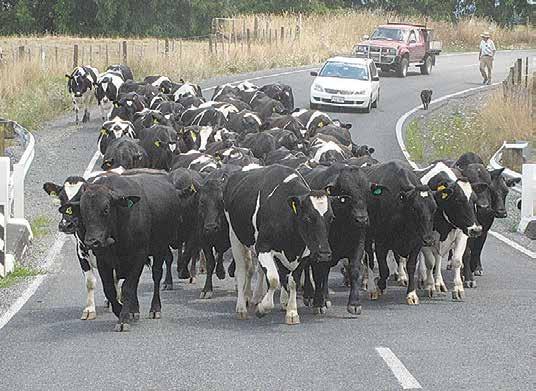
The events - in Waikato on April 27 and Canterbury on May 9will give dairy farmers the opportunity to hear from talented scientists and sector experts about practical science-based solutions and innovation to tackle sector challenges.
DairyNZ chief executive Dr Tim Mackle says this year’s forums are focused on the theme ‘Research to reality: practical science for dairy farmers.’

“The dairy sector continues to face a range of challenges, from workforce shortages to climate change. To combat these challenges, our DairyNZ team is continuing to research and bring practical science-based solutions and innovation to
Farmers’ Forum 2023
Waikato
the farm, now and for the future,” he says.
“The forum will provide a unique opportunity for farmers to engage and connect with other farmers, scientists and experts, while hearing scientific insights and the latest research and development, through a mix of great speakers, displays and interactive sessions,” he says.
Scientists and sector leaders will discuss a range of topics, including research underway to improve water qual-
ity, boost reproduction, reduce nitrogen loss and improve climate change adaption.
Farmers’ Forum events include practical informa-
tion sessions discussing how to design internationally competitive farming systems for the future, and understanding how the herb plantain can help
reduce nitrogen loss. A lunchtime science expo will give farmers an opportunity to connect directly with scientists and researchers.
Farmers are encouraged to register now for the Waikato and Canterbury events to secure their spot. Registrations are open and free for levy-
paying dairy farmers and their staff. For more information, the full programme and registration, visit dairynz. co.nz/farmersforum
SPECIAL REPORTS
Moving Day is a huge day in the farming calendar. The farmers’ checklist will be extensive and include everything from stock transport regulations, to hooking up the power and internet, and more in between. Our special report will cover all aspects that farmers need to ensure their move goes smoothly. If your product or service is on that list, contact us now to advertise.
To be in this special report contact your advertising representative now to promote your products and/or service to all NZ dairy farmers and sharemilkers.
FEATURE: 2 May 2023
BOOKING DEADLINE: 19 April 2023
MATERIAL REQUIRED: 25 April 2023
DAIRY NEWS APRIL 18, 2023 MANAGEMENT // 15
Don Rowlands Centre, Karapiro Thursday, 27 April 2023
Canterbury Ashburton Events Centre, Ashburton
Tuesday, 9 May 2023
The upcoming DairyZN Farmers Forum will allow farmers to engage and connect with other farmers, scientists and experts.
Contact your closest Sales Representative
Auckland Stephen Pollard .......... Ph 021-963 166 Waikato Lisa Wise Ph 027-369 9218 Wellington Ron Mackay ............... Ph 021-453 914 Christchurch Kaye Sutherland Ph 021-221 1994
MOVING DAY
$85m raised by Halter ‘will boost service delivery’
COW COLLAR technology maker Halter has raised $85 million from an impressive list of investors from around the globe.
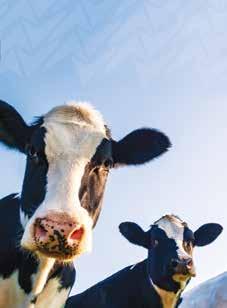


The Series C funding, led by Bessemer Ven
Do you know if your feed Find out at the NZFMA Fieldays



Beck and Icehouse ventures.
Halter says Bessemer, a Tier 1 US-based venture capital firm with a global investment team, is renowned for backing transformational companies, including LinkedIn, RocketLab and Pinterest.
It claims, despite a slowdown in capital mar-


kets, investors were attracted to Halter’s groundbreaking technology that enables more efficient farming.
Halter enables farmers to remotely shift, virtually fence, and proactively monitor their cows’ health and behaviour. The company says its worldfirst system is supporting
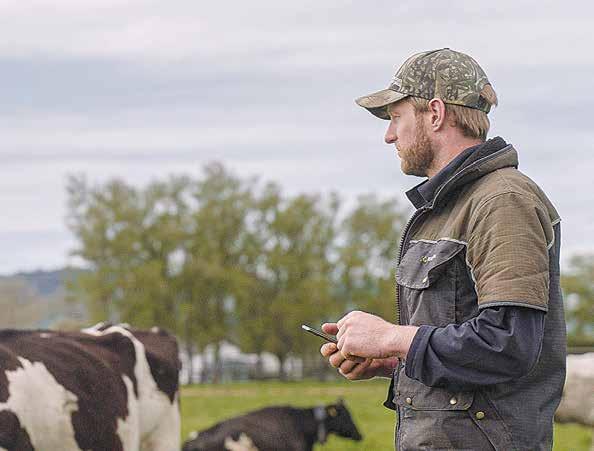
farmers to combat labour challenges, lift milk production while lowering inputs, and enable 24/7 monitoring of the health of their cows.
Halter chief executive Craig Piggott says the Series C capital raise will accelerate the value Halter delivers to customers.
“Our number one priority is investing in our farmers.
“This money will go directly towards delivering a system that helps farmers run more productive and sustainable operations. Historically, running a sustainable
farming operation has been at the expense of production.”
Piggott says Halter farmers can achieve both.
Southland farmer Peter Templeton says Halter saves him over 2.5 hours a day just getting cows to the shed.
“We’re also up 10k in milk solids and have significantly reduced the amount of nitrogen we use.
Plus, the farming team is happier, there’s less fatigue, we are sharper at decision-making, and we have more accurate grazing outcomes. Halter has fundamentally changed
the way we farm.”
Tess Hatch, partner at Bessemer Venture Partners, says Halter revolutionises livestock farms, enabling farmers to break free from the time-intensive constraints of conventional farming.
“The company’s suite of SaaS products manages everything from pasture grazing and livestock movements to animal health, ultimately reducing labour costs and increasing revenue, while at the same time decreasing farm emissions,” says Hatch.
Halter, founded in 2016 by Piggott, is made up of
a diverse team, all driven to unlock a more productive and sustainable future of farming.
Over the last seven years, the team has grown to over 180 talented and passionate engineers, data scientists, farmers, designers and business people.
Halter says it is deploying onto new farms daily across New Zealand. Collars are leased under a per-cow subscription model based on farmers’ required features. Halter retains ownership of the collars and therefore takes responsibility for their maintenance.
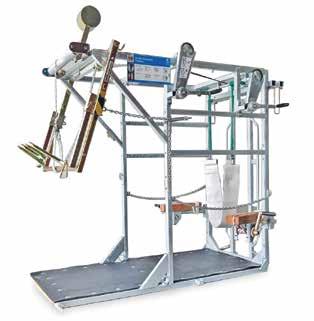
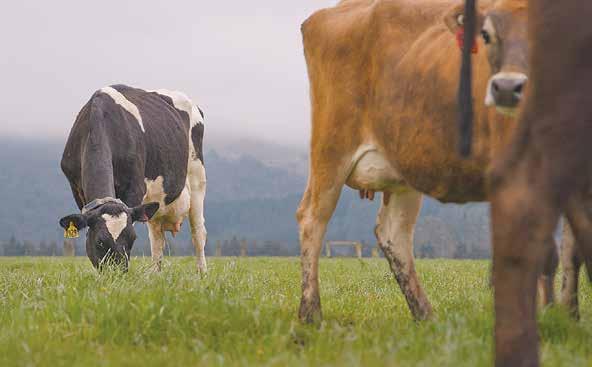
16 // ANIMAL HEALTH Make sure your feed is FeedSafe NZ accredited
DAIRY NEWS APRIL 18, 2023
Halter says the $85m will go directly towards delivering a system that helps farmers run more productive and sustainable operations.
Picture shows standard crush with some of the optional extras T+C’s apply. One lucky winner drawn from Standard Wopa crush sales between 1/1/23 and 18/12/23, and receive the cost of your crush $6735+gst back excluding accessories and freight. • Care and attention to every c0mponent, from bolted joints to high quality steel. • Construction and materials that can handle stress for maximum durability and safety. • Arrives assembled with optional add-on components to adapt the WOPA for flexible on-farm use. Hoof Trimming Crush The crush your cows prefer VISIT US: MYSTERY CREEK FIELD DAYS#i29 14-17JUNE Faster and easier to use Standard Crush from $6,735 +gst WIN YOUR CRUSH IN 2023 Simply purchase a WOPA standard crush and go into the draw to win back the value of your crush* Freephone 0800 833 463 Email info@veehof.co.nz www.veehof.co.nz “ Supporting farmers to become the best they can be ” To find out more, call us today! Freephone 0800 833 463 Do you know if your feed is FeedSafe accredited? Find out at the NZFMA Fieldays stand NZFMA Fieldays stand number AG 7C feedsafe-15x11.pdf 1 20/04/21 5:09 PM Do you know if your feed is FeedSafe NZ accredited?
Halter enables farmers to remotely shift, virtually fence, and proactively monitor their cows’ health and behaviour.
Early lameness detection helps improve herd performance
EARLY DETECTION
of lameness is a crucial factor in maintaining a profitable and healthy dairy herd.
Studies conducted in New Zealand suggest that around 26% of cows in
shed. The installation will require a suitable exit race, EID reader, and a reliable internet connection.
Using the DairyNZ locomotion scoring metric, users are provided with a 300-point spectrum of healthy (0.00) through to severely lame (3.00). Scores are
a large herd suffer from some form of lameness each year, resulting in significant financial losses for farmers.
Those costs can include decreased milk production, a reduction in reproductive performance, alongside possible vet bills, treatment costs and time taken by staff to treat animals.
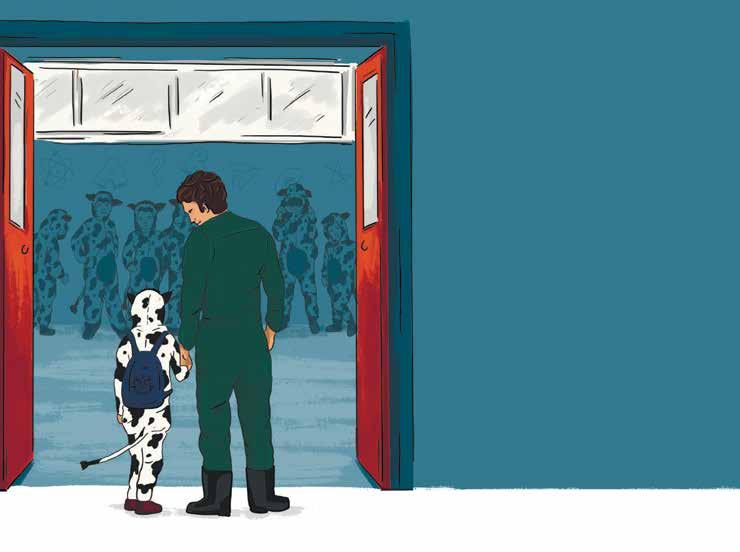
The impact of lameness on fertility is particularly significant, with UK research indicating that lame cows ovulate earlier but show signs of heat later than healthy cows, meaning the chances of getting a lame cow in calf are significantly reduced.
To help farmers address the issue, NZbased company OmniEye has developed an innovative visual monitoring system that uses vettrained artificial intelligence to locomotion score dairy cows.
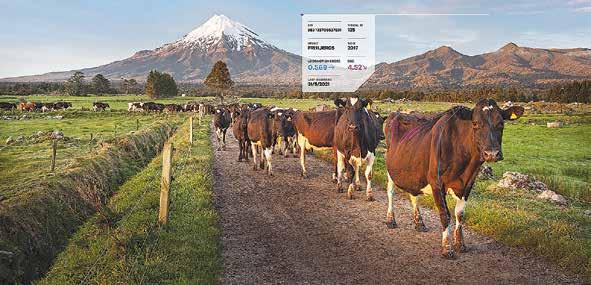
Providing farmers with an accurate 0-3 score, the system enables early detection of lameness, allowing prompt and effective treatment that can minimise the impact on a herd’s bottom line.
The on-farm hardware required to run the system includes a CCTV camera mounted perpendicular to the exit race and a small enclosure mounted inside the
presented in a dashboard along with associated videos, allowing for remote diagnosis and effective treatment management.
The system is designed to supplement stockmanship skills and can work symbiotically with wearable technology to provide farmers with a comprehensive understanding of the health and wellbeing of their cows.
The system is currently in use on 30 dairy farms across New Zealand, with farmers reporting significant improvements in their ability to detect problems early and effectively manage the health of their herds.
Hayden Ferriman of Three Leaf Farms says OmniEye has become part of their daily routine.
“It allows us to catch problems earlier and as a business owner, it gives me peace of mind when I’m not in the shed.”
Meanwhile Kurt Zenipmal, manager at Medstone Dairies, says, “alongside the benefits of early lameness detection, we can also use the videos and scores to keep an eye on the cows we’ve treated, then set up auto drafts to put them back in the main herd once they’ve come right rather than watching them from the vet stand and manually drafting”. www.omnieye.co.nz
Joining a herd is tough for any youngster.
The reality is viruses love crowds with kindergartens and schools being breeding grounds for – well nearly anything! This is why we vaccinate – to reduce viral transmission, control an outbreak and offer a level of protection over and above any form of herd immunity.
The same can be said for our bovine youngsters whose naive immune systems meet up with all kinds of diseases –PI3, BVD and IBR. Once contracted the IBR virus stays for life, reactivating (and transmitting) at times of stress.
Evidence shows that the IBR virus is present throughout NZ. At Agilis we are wanting to better understand more about this disease and to do so we need your help.
Go to www.schoolofhardknocks.co.nz
If you think there is a possibility of IBR being present in your herd please complete the form so we can get in touch.
HELP BREAK THE CYCLE
Consider vaccinating your calves prior to being put out for grazing and before being introduced into your main herd, also discuss IBR testing with your vet.
SYMPTOMS OF IBR INCLUDE:
COUGH
Often mistaken or confused with lungworm
CONJUNCTIVITIS
Can be mistaken as pink eye
SICK COWS
As a respiratory based disease snotty noses and noisy breathing can all be signs of IBR.
DULLNESS AND INAPPETANCE
Often considered as a symptom of mastitis or ketosis but it is often a sign of IBR.
A DROP IN MILK PRODUCTION
This is often attributed to a myriad of things but because the IBR virus can cause fever, pharyngitis & inappetence the result is often seen in a milk drop (as high as 30%1 ), particularly in heifers.
POOR FERTILITY
The IBR virus targets lung and reproductive tissues (uterus, ovaries, vagina) and has also been associated with increased somatic cell counts. Infection can cause inflammation (metritis, vaginitis and oophoritis) which can result in sub-fertility. A NZ case study2 showed that a bull infected by a reactivated cow went on to infect an entire mob of cows, resulting in 24 of 54 returning empty.
DAIRY NEWS APRIL 18, 2023 ANIMAL HEALTH // 17
MARK DANIEL markd@ruralnews.co.nz
“It allows us to catch problems earlier and as a business owner, it gives me peace of mind when I’m not in the shed.”
Studies conducted in New Zealand suggest that around 26% of cows in a large herd suffer from some form of lameness each year.
HELP US LEARN MORE Had IBR?
1. Pereira, M.H.C et al. (2012) Anim Reprod Sci 2. Askin, B. (2013) NZVA Conference proc.
3 IBR outbreaks for March Mid-Canterbury region
Norwood expands Kuhn network
MARK DANIEL markd@ruralnews.co.nz
NORWOOD HAS imported and distributed Kuhn machinery since 2007, but until now the brand has only been sold through three of Norwood’s 21 dealerships.
With immediate effect, Norwood customers will have greater access to Kuhn’s cultivation, seeding and grassland machinery, with the brand being available at additional Norwood dealership locations throughout the country.
The expanded footprint will include the Norwood dealerships in Hawera, Hastings, Marlborough, the West Coast, Christchurch, and Mosgiel, while Norwood Hamilton will support Norwood Taupo with Kuhn sales and service.

“Kuhn is a leading manufacturer of forage harvesting, livestock management, and cultivation machinery familiar to New Zealand’s farmers,” says Rod Gardner, Norwood’s national product manager.
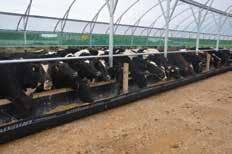
“Their equipment will add coverage to Norwood’s portfolio, particularly in the hay and harvesting product lines.
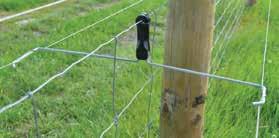
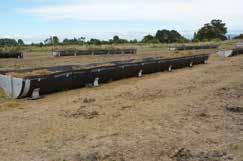
“Norwood regularly reviews its product portfolio to ensure the brands it represents deliver the most benefit to the NZ farmers, so new products like the VBP 7190 combi baler, offer versatility and numerous options that will be well received more easily for our customers,” says Gardner.
The existing dealer network remains unchanged and will continue to serve existing Kuhn customers.

VEGGIE OIL SET TO POWER TRACTORS

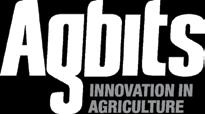
WHILE WE have become accustomed to vehicle manufacturers offering alternative fuel sources for its ranges, other than New Holland with its commercially available T6 Methane tractors, the agricultural landscape is firmly fixated on diesel power.

With the realisation that current battery technology does not lend itself to agricultural situations, tractor manufacturers have looked a little more closely at alternative fuels to power their compression ignition (CI) engines.
Kubota is the latest to announce that its new tractors are suited to running on hydrotreated vegetable oil (HVO).

The company has also confirmed that it is possible for its new dieselengine tractors to run on both HVO and GTL (gas to liquid) which will contribute to a lower carbon footprint for Kubota IC engines.
As a manufacturer of industrial engines, tractors, grounds care and construction equipment, Kubota has realised that HVO, which is synthe-

sised from vegetable oil and fat, is likely to become increasingly popular due to its environmental benefits. GTL meanwhile is synthesised from natural gas, therefore its contribution to reducing total carbon emissions is somewhat reduced.
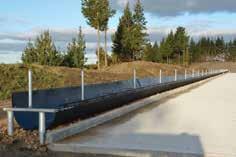
Having undergone extensive trials to evaluate any effect on the performance and achieving a clean bill of health, Kubota has confirmed that that any paraffinic fuel that complies with the European standard EN15940 is suitable for use across its range of diesel engines. The company also notes that there is no need to flush fuel tanks or change filters, as HVO and GTL, meeting the EU standard, are safe to mix with common diesel.
There are changes to existing maintenance intervals or warranty conditions when using these fuels, although operators may notice a slight degradation in engine performance when using them due to the lower energy density of paraffinic fuels, compared to diesel.
DAIRY NEWS APRIL 18, 2023 18 // FEEDING OUT
Kubota has announced that its new tractors are suited to running on hydrotreated vegetable oil (HVO).
PHONE 0800 4 AGBITS | 0800 4 242 487 WEBSITE www.agbits.co.nz New
With immediate effect, Norwood customers will have greater access to Kuhn’s cultivation, seeding and grassland machinery. Nothing beats a Flexirigger
Mobile Feeder
“Designed by a Farmer for Farmers”
Catch crops lifts DM production
THE PURPOSE of a catch crop is to increase annual dry matter production, to take up soil mineral and urine nitrogen and to reduce the risk of leaching or runoff.

The key attributes of catch crops when following autumn or winter grazed crops are that they: are cold tolerant, winter active and have fibrous deep root systems capa-
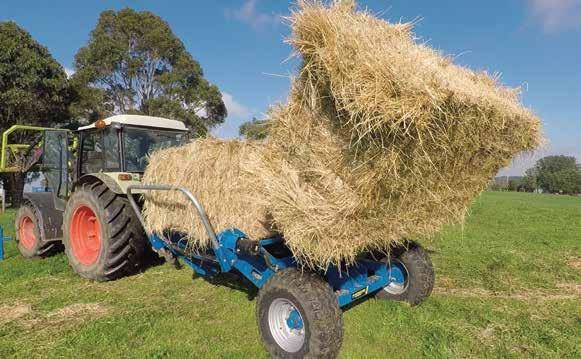
ble of removing nitrogen at depth.
Catch crop benefits vary depending on weather conditions, particularly during establishment, with direct-drilling or light pre-drilling cultivation being recommended methods where possible to minimise nitrogen mineralisation.
The gross margins (revenue minus costs)
EXAMPLES OF CATCH CROPS
■ Oats: A low temperature germinating, fast-growing cereal that can be sown in autumn, winter and spring. Used for winter green feed, green manure or silage.
■ Triticale: Tall cereals developed from crossing wheat and ryecorn, some varieties can be planted in autumn and winter behind grazed crops.
■ Ryecorn: Used in dryland situations where it is sown in early summer for grazing through until spring.
and cents/kgDM of catch crops can be used to compare different crops.
The numbers will vary depending on the yield and how the crop fits into an individual farm system, which is influenced by catch crop sowing date, the timing of feed requirements and the sowing date of the following crop or pasture.
The Forages for
■ Italian ryegrass: Establishes quickly and will grow at lower temperatures than perennial ryegrass. It can be sown by itself or in combination with a cereal crop.
■ Faba beans: Best planted between early March to late April following a summer crop to use as a late spring feed. This legume fixes nitrogen, which in some crop rotations can be beneficial for the next crop. Visit www.dairynz.co.nz
Reduced Nitrate Leaching (FRNL) research trials gross margin and c/kg DM varied from $173/ha to $1263/ha and 8.1 c/kg DM to 15.3 c/kg DM respectively.
FRNL ran trials of different crops comparing crop nitrogen uptake and residual soil nitrogen as
indicators of the risk of nitrate leaching.
A variety of species or combinations can be used as catch crops. Consider the below when selecting species or combinations thereof:
Establishment opportunities of the catch crop; what is the usual soil tem-
perature at the time of planting and can heavy machinery normally access the paddock at that time of year?
Main crop/regrassing planting date; consider effect on potential yield of the following crop or pasture.
Ability to fit into the
farm system, e.g. planned crop rotation, harvesting or grazing dates, end use of land planted (permanent pasture or crop), use of catch crop:
■ green manure
■ grazing
■ green chop / whole crop silage
■ grain or straw
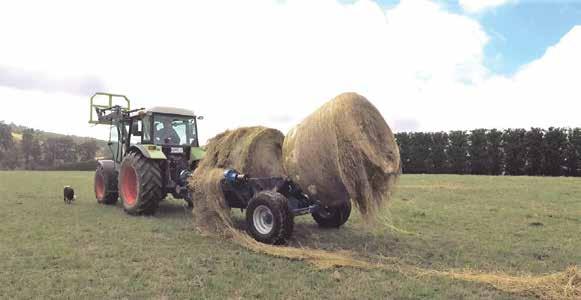
DAIRY NEWS APRIL 18, 2023 FEEDING OUT // 19
Catch crops like oats and cereal benefit the bottom line and environment. McIntosh FarM MachInery www.mcintosh.net.nz | 0800 622 276 STRENGTH / QUALITY / PERFORMANCE
FARM MACHINERY
Feeders Round or Square WE’VE GOT YOU COVERED! Now with side protection rails and 4 prong fork attachment, McIntosh Bale Feeders can handle all types of round and large square bales with ease. Contact us for further information STRENGTH / QUALITY / PERFORMANCE
Manure Spreaders Bale
New bale machines cut feeding times
BRETT MCINTOSH of the Palmerston North-based family agricultural engineering firm McIntosh, says their Multi-4 and 5 bale feeders offer a major leap in productivity if you need to lift and feed 10 or more bales daily.
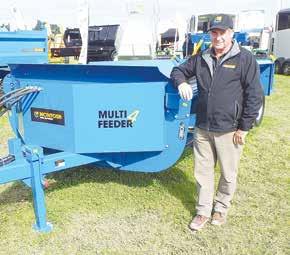
“While 2-bale machines are particularly common, anyone feeding a large number of bales will know they mean multiple trips back from the paddock to the bale stack to reload and the added inconvenience of being ‘mobbed’ by cattle each time you enter the paddock,” says Brett.
Well known for building machines that incorporate the “must-haves” of strength, ease of use and durability, a closer look at the Multi-4 reveals a machine that features two box sections running through the bale cradle to deliver a low centre of
gravity that imparts stability and a wide cradle that means delivered feed is not run over by the trailer wheels.
Designed to carry three bales in the cradle and a fourth on the twinrammed lifting forks, the Multi Feeder is at home lifting and feeding both round and occasional large square bales, carrying the loads on a tandem axle layout. It has a tare
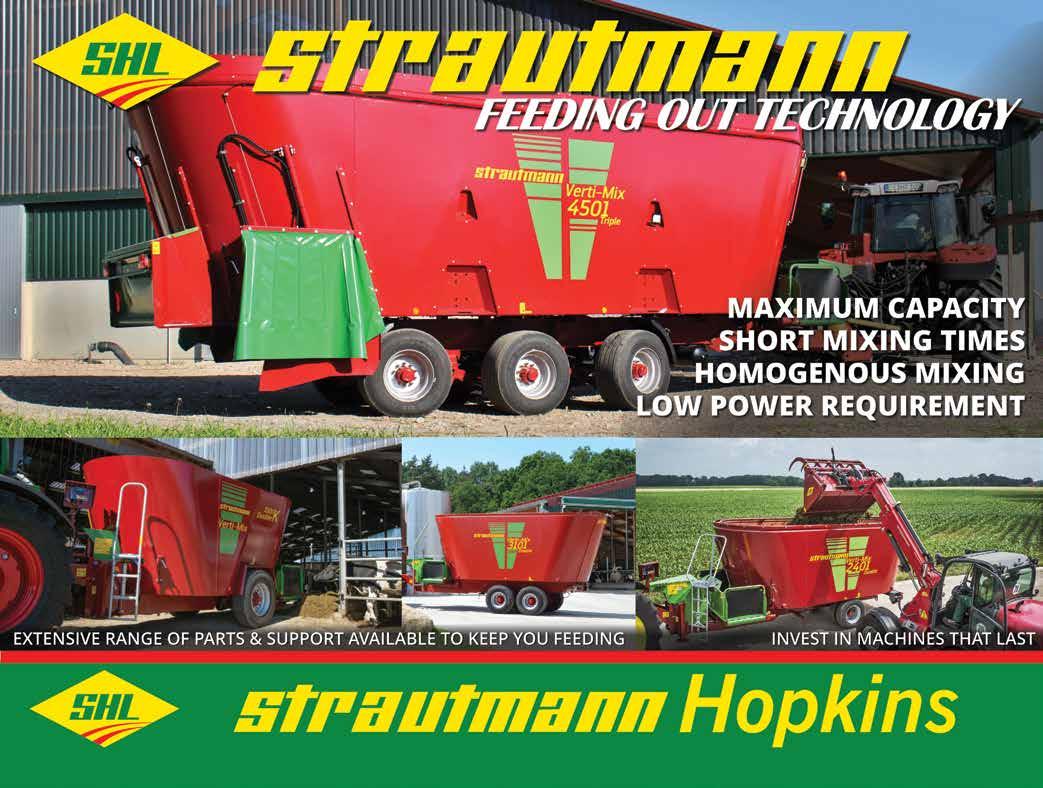
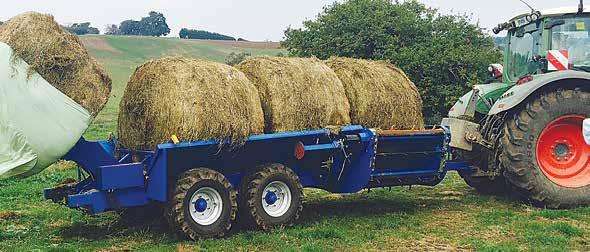
weight of 2180kg.
Backing up to a row of bales, bales are lifted on triple spikes, while the fork design ensures bales are placed in the cradle, rather than being dropped from a height.
Once loaded, bales are pushed forward by the rear backstop, before it returns to the start position to accept another bale. A simple diverter valve switches between
the rear lifting forks and the bale pusher, meaning only two rear remotes are required to complete three functions. In operation, returning the backstop to its rearmost position serves to re-establish the hydraulic feed to the rear forks.
A clever loading design detail – that Brett McIntosh admits was dreamt up by an Australian dealer – sees rotating teeth on
the unloading bars that, when set in the loading position (the yellow unloading bar is stopped at the highest point of the discharge cradle), allow bales to be pushed forward without jamming against the fixed teeth of the discharge cradle, while also delivering a positive movement when unloading.
Offering the ability to feed to either side,
the Multi-4 incorporates 3-inch, 12,000lb zincplated roller chains, an 8-tooth sprocket system for better drive and a longer life and a HD hydraulic motor with a 1.25-inch drive shaft.
Setting up for bale loading and feeding, a low overall height of only 1100mm allows operators to remove plastic or net wrap easily, while
strategically-placed waste bins to the side and the front of the machine ensure waste is segregated for recycling.
Standard equipment includes a swivel drawbar and 11.5/8-15.3 tyres, while options include a square bale attachment, a trough extension arm, rear lighting kit and oversized or tractor tread tyre equipment.
DAIRY NEWS APRIL 18, 2023 20 // FEEDING OUT
Brett Mcintosh of the Palmerston North-based family agricultural engineering firm McIntosh.
Phone 06 354 2813 • enquiries@stratumann.co.nz
Multi-4 and 5 bale feeders offer a major leap in productivity if you need to lift and feed 10 or more bales daily.
Tough times for mixer wagon maker





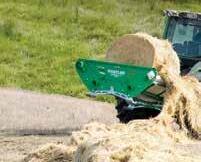










UP TO 50 jobs look likely to be axed at Irish mixer wagon manufacturer Keenan, who have weathered the post-Covid storm with some difficulties that saw production and profitability compromised.





Based at Borris in County Carlow, the business, owned by global nutrition company Alltech since 2016, currently employs around 115 people.

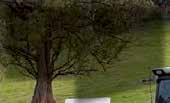


According to the owners, major hikes in steel prices, component supply chain issues and a lack of available labour have all contributed to their difficulties. Alltech, based in Kentucky US, says it is fully behind the brand and working towards finding solutions for their problems.


A spokesperson said, “Like many other companies in the industry, Keenan has faced difficult headwinds over the past two to three years.






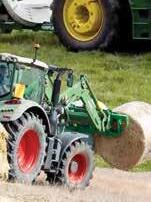





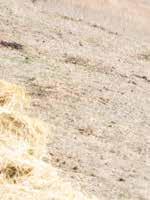















































































“We still believe in the potential we saw at Keenan when we purchased the business in 2016, yet we now realise that we did not integrate it deeply enough in the Alltech family. As a result, Keenan has struggled to stay resilient during these recent challenges.”
Alltech has also revealed that it is investigating the possibility of outsourcing its manufacturing functions to other companies, with Turkey being mentioned in other news articles, although Alltech has stated that Keenan will remain an Irish company and continue to operate from its current site.

The spokesperson commented: “Looking to complement our expertise, we are looking at manufacturing partnerships, as we believe this might enable us to meet our customer expectations for quality, on-time delivery and operational support in a currently challenging manufacturing environment.




“At this point, these conversations are only exploratory, and we have no intention of developing a Keenan manufacturing facility on any other location.”






As Dairy News goes to press, we understand that several staff members have received letters notifying them of a risk of redundancy, so they are now in a period of consultation before any final decisions are made.





@dairy_news facebook.com/dairynews







DAIRY NEWS APRIL 18, 2023 FEEDING OUT // 21
All prices shown are base prices, without any extras and options. Deals valid until 31/5/23. Call our friendly team today! leaving your tractor > Grab & slice the bale with one machine FROM $11,790+GST Chain Harrows > Revitalise paddocks > Improve manure uptake > Lower fertiliser costs FROM $10,990+GST SWIFTBLADE Manure Scrapers > Clean environment for herd > Maximise manure value > Save time FROM $3,890+GST SOFTHANDS RANGE > Euro Hitch & Hoses Standard > No pinching or tearing of wrap > 4 Year Warranty SWIFTHITCH RANGE > Class-leading visibility > Replacable wearpad & pin > Self-aligning latch Heavy Duty FROM $1,795 +GST Super Duty FROM $2,750 +GST EZFEED RANGE > 100% Roller Chains > Roto-Moulded Hungry Boards > Feed out either side > Simple operation > Proven platform FROM $63,900+GST HUSTLEREQUIPMENT.COM 0800 487 853 COMBI CM & RX RANGES Has your old feedout wagon come to the end of its road? Is it time to put it out to pasture? Order your wagon of tomorrow at today’s prices. FROM $72,900+GST LM100 Farmers Round Bale Handler FROM $3,990+GST LX200 Contractors Round & Square Bale Handler FROM $4,990+GST IT’S FEEDIN’ TIME! 100% roller chains Virtually indestructible hungry boards TwinFeed™ feeds out either side Feed out any shape bale –rounds or squares • Teases hay apart • Sturdy & simple – less maintenance • • CHAIN BALE UNROLLERS A NEW FAMILIAR FRIEND • 12,000 lb roller chains • Feeds out either side • Auto-connection system make operation quicker & simpler • NEW compact size even easier to operate in tight situations READING THE PAPER ONLINE HAS NEVER BEEN EASIER Read us until the cows come home! ❱❱ Breaking news ❱❱ Management ❱❱ Animal health ❱❱ Agribusiness ❱❱ Machinery & Products reviews ❱❱ Competitions... and much more All the latest stories and more at www.dairynews.co.nz Irish mixer wagon manufacturer Keenan is cutting jobs in a bid to weather the post-Covid economic storm.
Effluent specialist, Abbey boosts production by 20%
MARK DANIEL markd@ruralnews.co.nz

SINCE COVID-19 arrived on the scene in early 2020, farmers and contractors have become accustomed to demand often exceeding supply – due to shutdowns and labour and material shortages extending delivery times.
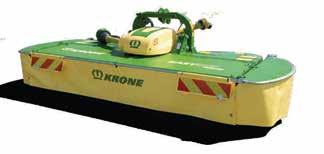

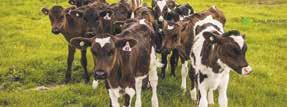
Well known effluent handling specialists Abbey Machinery, of Nenagh, Co. Tipperary, is to up its game with a major investment in its factory to
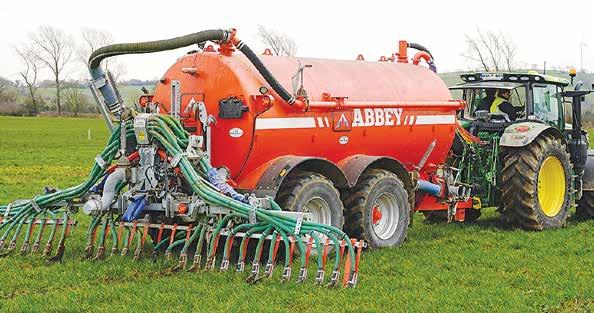
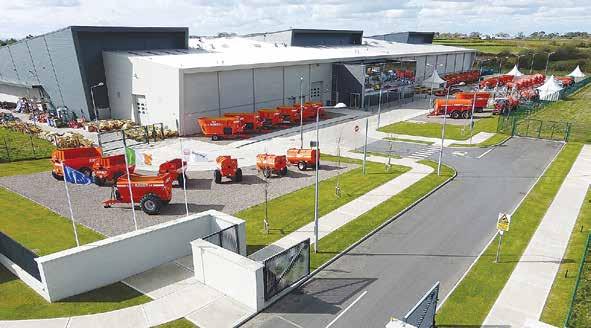
create an extra 10,000ft² of floor space.
The expansion, alongside the introduction of new metal-cutting machines to the production process, will increase throughput by 20% while at the same time reduce the operation’s dependency on grid electricity.
Developed on a 12ha greenfield site in 2016, with continuously updated manufacturing technology since then, investments include an
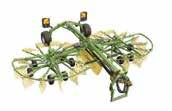
energy-efficient fibre laser machine, which replaced a carbon dioxide laser unit, and additional plasmacutting upgrades to increase product quality and increase capacity.
Ongoing sustainability initiatives have significantly reduced the company’s carbon footprint and increased energy efficiencies, with the latest introduction being a 250kW solar system to reduce dependency on the grid. This means that currently over 60% of the electricity used at Abbey Machinery is sourced from renewable energy, with a commitment to sourcing 100% green energy in the longterm.
Further to the energy savings, the company also consumes less water than the average household as a result of the rainwater-


harvesting system it has installed.

Clodagh Cavanagh, managing director of the company, is committed to the company philosophy of continuing to manufacture high-quality agricultural machinery, while reducing its carbon footprint and increasing sustainability.
“Our new factory expansion and investments in sustainability initiatives demonstrate our commitment to continually improving our manufacturing process and delivering high-quality products to our customers,” she said.
“With the expansion and introduction of new robotic welding machines, Abbey customers can be confident that the manufacturing process is consistent with the highest weld quality.”
DAIRY NEWS APRIL 18, 2023 22 // MACHINERY & PRODUCTS
“Abbey customers can be confident that the manufacturing process is consistent with the highest weld quality.”
Abbey Machinery, of Nenagh, Co. Tipperary, has created an extra 10,000ft² of floor space at its factory.
Are you hitting your target market? Contact your local sales representative for more information Auckland Stephen Pollard Ph 021-963 166 Waikato Lisa Wise ............... Ph 027-369 9218 Wellington Ron Mackay Ph 021-453 914 Christchurch Kaye Sutherland Ph 021-221 1994 www.dairynews.co.nz ■ BREAKING NEWS ■ MACHINERY REVIEWS ■ MANAGEMENT STORIES ■ AND MUCH MORE... For more information call us on 06 370 0390 www.tulloch.nz Dealers located nationwide Produce exceptional results
in
NEW - VENDRO TEDDERS Working width from 4.6m to 11m • Rotor construction is
the highest strength and rigidity to
tine function. •
SWADRO TC RAKES Working
from 6.4m
9.3m •
EASYCUT MOWERS • The toughest cutterbar on the market. • SafeCut & SmartCut systems. • Front, rear or trailed options - with or without conditioner.
Abbey says ongoing sustainability initiatives have significantly reduced the company’s carbon footprint and increased energy efficiencies.
with the Krone machinery range. Invest
longevity and quality. Invest in the best.
of
allow optimised
New Optiturn 3D tines to spread the swath perfectly.
width
to
Low maintenance, nimble & designed for heavy silage conditions. • DuraMax Cam Track ensures superior shaped windrows.
Versatile spreaders
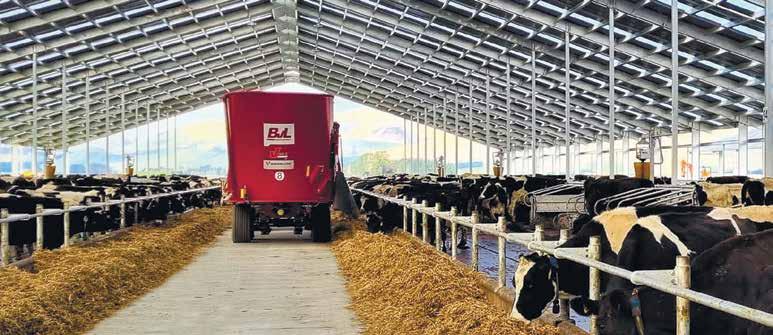
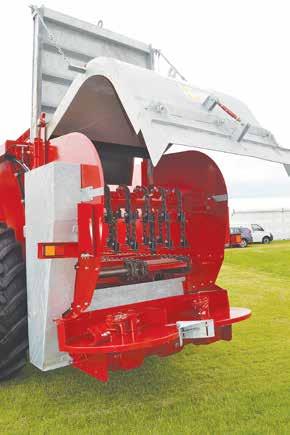
DISTRIBUTED IN New Zealand by Giltrap Agrizone in the North Island and Cochranes of Canterbury in the South Island, HiSpec muck spreaders can handle a wide variety of manures, with the top-end Xcel 1250 capable of dealing with everything from burnt lime to chicken manure to effluent.
Offering a 12-tonne capacity (14.5cu.m), two floor chains move material to the rear of the wagon, where it meets a horizontal shredding rotor, fitted with 22 freeswinging, heavy-duty Hardox flails.
As they spin, the flails shred the manure against the Hardox hood, ensuring the product to be spread is pulverised before being delivered to the rotary spreading vanes.
The driveline (1000rpm) is directed to a gearbox at the rear of the machine, that in turn uses a chain drive to spin the shredding rotor at over 230rpm. The 1100mm spreading rotors are also driven by the gearbox, to a speed of 520rpm, delivering a spreading width of up to 24 metres, depending on the density
of the spread material. The shear-bolt protected rotors are fitted with twin adjustable Hardox steel vanes, with the option of four vanes for lighter materials such as mushroom compost.
Material is moved to the shredding rotor via twin, hydraulically driven floor chains, which feature in-cab speed adjustment to control delivery to the rotor, with the ability to clear a load in less than five minutes.
Weighing in at around seven tonnes, the combined load is carried on 580-70R38 tractor grip tyres, enclosed in galvanised steel mudguards.
The unique rotor and chain design allows stones or foreign objects to pass through more easily than vertical auger machines, while the intensively processed material can be spread finely and evenly to be utilised by plants, while at the same time reducing the turnaround back into the grazing cycle.
Featuring automatic chain lubrication and a centralised greasing system, maintenance is kept to a minimum, while hydraulic braking and LED lighting ensures safe operation. Optional equipment includes “greedy” boards for bulkier materials, while GPS
mapping and weigh cells can be used to provide proof of placement and spread volumes for regulatory authorities. www.gaz.co.nz

With over 2000 combinations across 78 basic types and 37 versions, BvL has a mixer wagon to suit every farming situation.
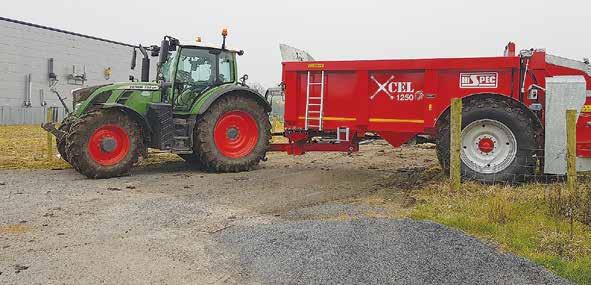
MADE FOR ME
LEASE FROM 1869* $ + GST PER MONTH
THREE REASONS TO CHOOSE BVL FOR YOUR NEXT MIXER WAGON:
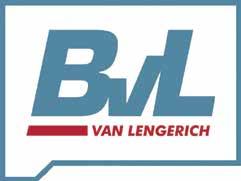
1: Fastest Mixing Speed
- Asymmetrical mixing wedges
- Power mixing auger
- Rolled mixing chamber walls
3: Nationwide Backup and Support
- Four branches nationwide
- Factory trained technicians
- Significant par ts stock holding
2: Longest Lasting Mixer Wagon
- Double overlapped welding
- High qualit y German steel
- Robust truck style chassis
- Double anti spill ring
Scan the QR code to find out which BvL Mixer Wagon would best suit your farming operation:

DAIRY NEWS APRIL 18, 2023 MACHINERY & PRODUCTS // 23
MARK DANIEL markd@ruralnews.co.nz
HiSpec muck spreaders can handle a wide variety of manures. Featuring automatic chain lubrication and a centralised greasing system, maintenance is kept to a minimum.
Call Gerry on 021 245 4471 *Normal lending criteria applies


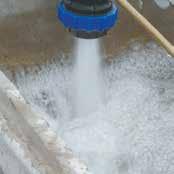
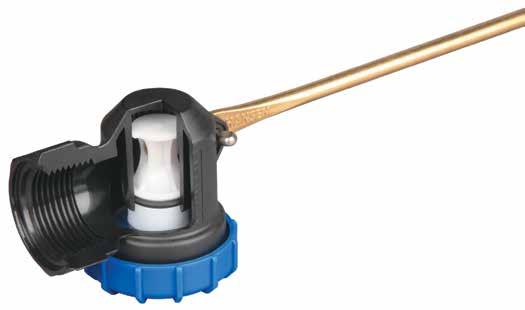









www.hansenproducts.co.nz The Hansen Superflo Valve has been design and built from the ground up to produce a High Performance Super Low Maintenance Valve. With it’s proven success it’s not difficult to see why so many farmers have embraced it. High Performance 188 L/min @ Slipper Fit Piston Helps Eliminate Stuck Valves Multiple Size Options Threaded Outlet for Portables, Washdown, Tanks, Irrigation HAND TESTED Reliable Trough Valve NEW Now includes 15, 20 & 25mm Adaptors in Superflo Standard Adaptor Pack Available at your local Rural Supply Store





















































































































































